1lumen selects and reviews products personally. We may earn affiliate commissions through our links, which help support our testing.
Olight Seeker 4 review
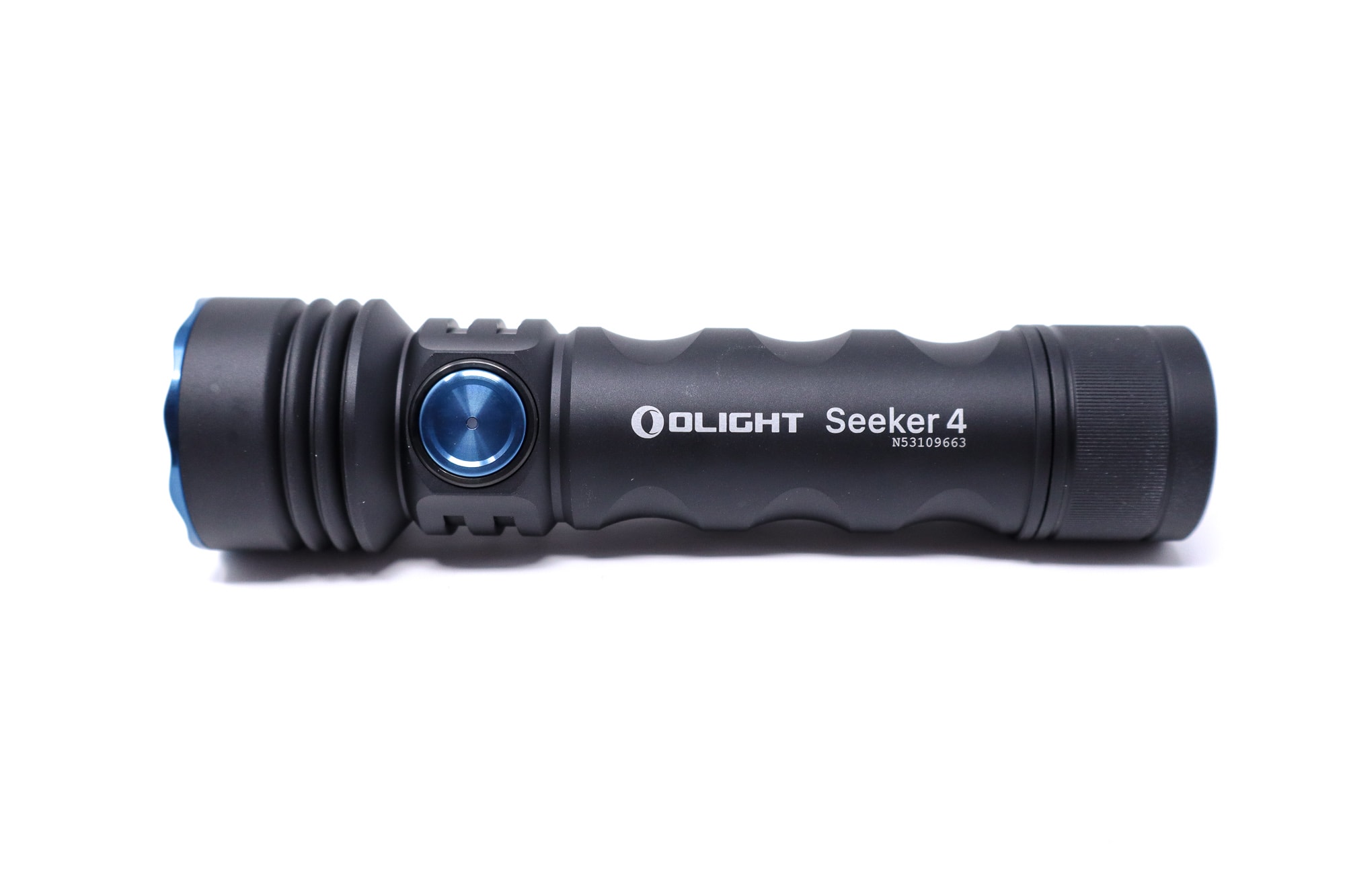
Olight Seeker 4 specs
| Brand & Model | Olight Seeker 4 |
|---|---|
| Flashlight category | EDC flashlight, General Purpose |
| LED | Cree XHP50.3 HI |
| Max. output | 3,100 lumens |
| Max. beam distance | 400 meters |
| Max. beam intensity | 40,260 cd |
| Battery config. | 1*21700 |
| Onboard charging | USB C |
| Main modes | 5 |
| Blinkies | Strobe |
| Waterproof | IPX8 |
| Review publication date | December 2023 |
Review intro:
Olight needs no introduction since everyone and their uncle’s best friend’s former co-worker knows who they are, but in case you’re the 1 percenter who doesn’t, Olight officially operates as Donggun Olight E-Commerce Technology Co. LTD.
They make flashlights and gear for professional use, outdoorsy EDC-type items and there’s a ton in the catalog. Moreover, Olight keeps improving and adding to said catalog, and 2023 has seen a bunch of additions. I reviewed the new Warrior X4, Warrior Nano, and now there’s another one, this one for the Seeker line. Marco reviewed the Seeker 4 Pro, and now I’ve got the regular Seeker 4. This one’s all new, joining the Seeker 4 Pro and Seeker 4 Mini. It’s also departing from the usual ‘Olightness’ I’m used to like the X4 with onboard USB C charging. Don’t worry, all the things we like and expect from Olight are present and accounted for, so let’s dig in.
Package quality.
Olight has some of the most thoughtful and functional packaging in the industry. Everything inside is nicely laid out and organized very thoughtfully. Like other Olight boxes, there’s a life-size image of the light on the top of the box. All the important bits are present and accounted for as well. Here’s what you get:
- Olight Seeker 4
- Olight ORB-217C50 5000 mAh 21700 battery
- USB C charging cable
- Lanyard
- User manual
This is a complete, ready to go kit. You would want to fully charge the battery to get the most runtime and output though. Unscrew the tailcap, remove the isolator (you need to actually remove the battery to get it out), and you’re good to go. The lanyard for the Seeker is new and unique for Olight. It’s a rubber soft-touch material, not a braided nylon cord this time. I kind of like it, but prefer the OG ones. Oddly, there’s no holster included.

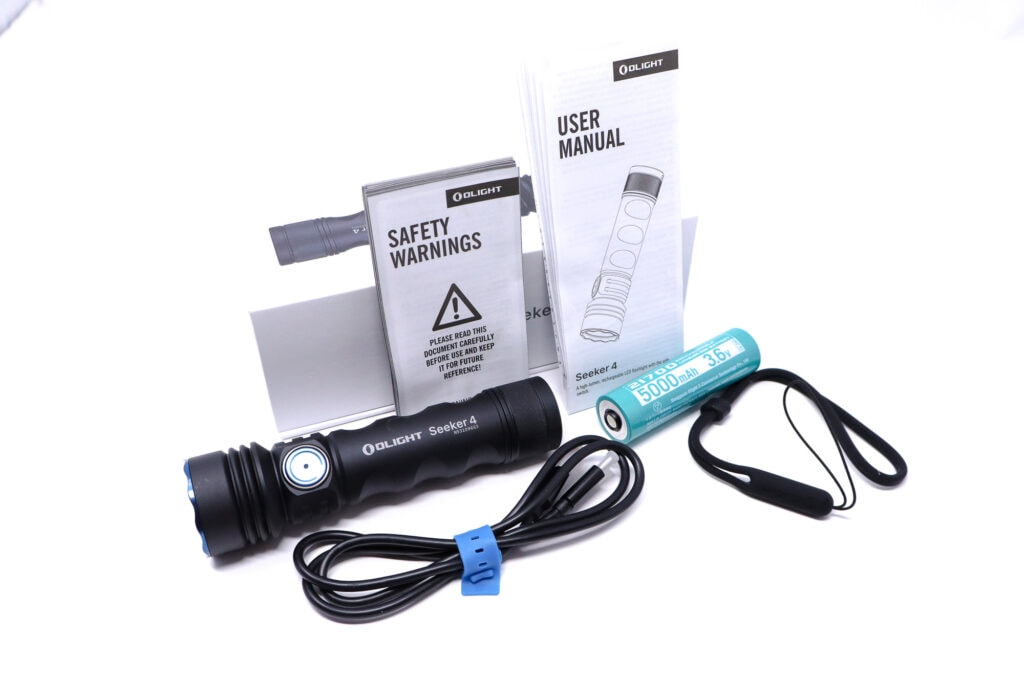
Flashlight in use, Build Quality, and Warranty
The Seeker 4 is a general purpose flashlight for well, general purpose lighting duties! It works anywhere, really, and it’s small enough to pocket. The form factor is roughly the same as the Acebeam E75, and fits the hand great. This isn’t something I’d EDC since it’s a bit bulky and portly for that (again, unless you like bulging pockets and sagging trousers), so a holster is your best bet for carry. I don’t mind the absence of the clip, but I’m kind of bummed they didn’t include a holster. It did fit into the Warrior X4 holster though.
For in-hand use, it’s great! Olight added gripping grooves to the side of the tube, which I really like as it adds some ergonomic comfort, and despite their being no knurling (aside from the tailcap which has micro reeding on the sides), combined with the grooves and grippy anodizing, it’s easy to handle and nicely non-slip. The weight and balance are also good, so it’s easy to maneuver in all grip positions.
There’s a single e-switch at the head. It has a blue anodized metal cover, and is set in an aluminum bezel with a central LED indicator for on/battery/charge state. It’s a bit proud and easy to locate by feel, but otherwise has no grippiness. The switch action is nice, with positive clicks and just the right amount of travel before activation. This Seeker 4 breaks the MCC cycle since there’s no MCC charging provision. Instead, Olight has given it the USB type C treatment, which I think is a big step in the right direction!
The charge input is on the back of the tailcap covered by a rotating shroud. The shroud is shaped like a butterfly with slots on the ‘wings’ for gripping, and the open/closed positions are detented to stay in place. The shroud looks to be plastic not metal, but it fits a tiny bit below the edge of the tailcap, so the light tail stands just fine. The rear threads are good-sized rectangular cut units sealed with a single o-ring. They’re pretty smooth and only lightly lubed, but fully anodized and mechanical lockout is possible.
Every Olight I’ve reviewed has been top-notch in build quality, fit, and finish. I have never had a quality issue or complaint with any Olight. The Seeker 4 carries that forward to a T. Prices will probably come in around $100 US on sale, with MSRP in the $120 range. I think it’s worth it and on sale, it’s competitively priced with other lights like the Acebeam E75.
The Seeker 4 is milled from high grade aluminum alloy, and the machining, fit, and finish are flawless with no misaligned parts, gaps, or blemishes. The edges are all chamfered and smoothed, and the silkscreen text and laser-etched graphics are crisp and sharp with nice contrast against the finish. The X4 comes in black and red anodizing. The review light came in black type III HA anodizing, and it’s a nice matte finish that I really like since it augments grip (and just feels nice in the hand).
With o-rings sealing everything, Olight says the light is good for IPX8, not the better IP68, but still good for 1.5 meter drops and full (temporary) immersion protection. The charge port is reportedly fully waterproof even when exposed. You can disassemble the Seeker 4 as long as it’s just the tailcap, since it’s glued up tight, and the threads are square cut, fully anodized, and super smooth with adequate lube. There’s a coil spring at the driver and a spring-loaded pogo contact (identical to the Warrior X4) for the tail. I’m always glad to see those since it protects the light from drops and ensures consistent electrical contact.
Olight’s warranty is the best in the industry: 30-day no-hassle returns and a as of January 2023, lights sold in certain markets (US, EU) get a lifetime warranty. From Olight: If you purchased an Olight® product from the USA after January 1st, 2023, the local service centers will honor your LIFETIME WARRANTY for your purchase. If your Olight product (including its structure, built-in battery, LED, or lens) ever experiences any issues, we promise to take care of it. If we are unable to repair your product, we will promptly replace it with a product in perfect working condition, which will be of equal or better physical condition. If your purchase is a limited or discontinued edition of Olight product, we will repair or replace it with another Olight product of the same or higher value. We will warrant all Olight products that exhibit any defects in material and workmanship under normal use. However, please note that this LIFETIME WARRANTY does not cover loss, theft, deliberate damage, or cosmetic damage. Even after-warranty support is generous with a 30% discount for a replacement item. Rechargeable batteries are covered with a 2-year warranty!
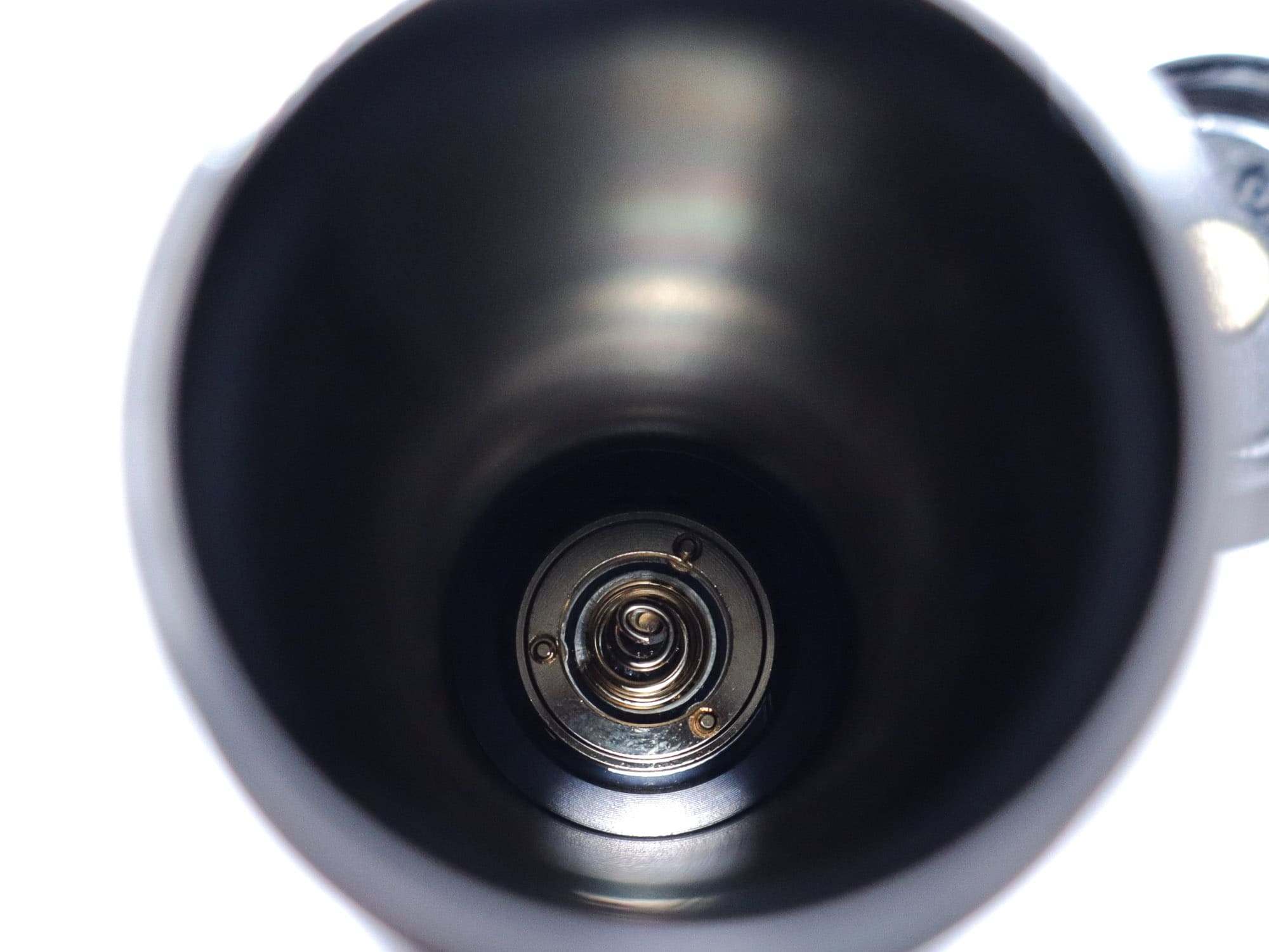
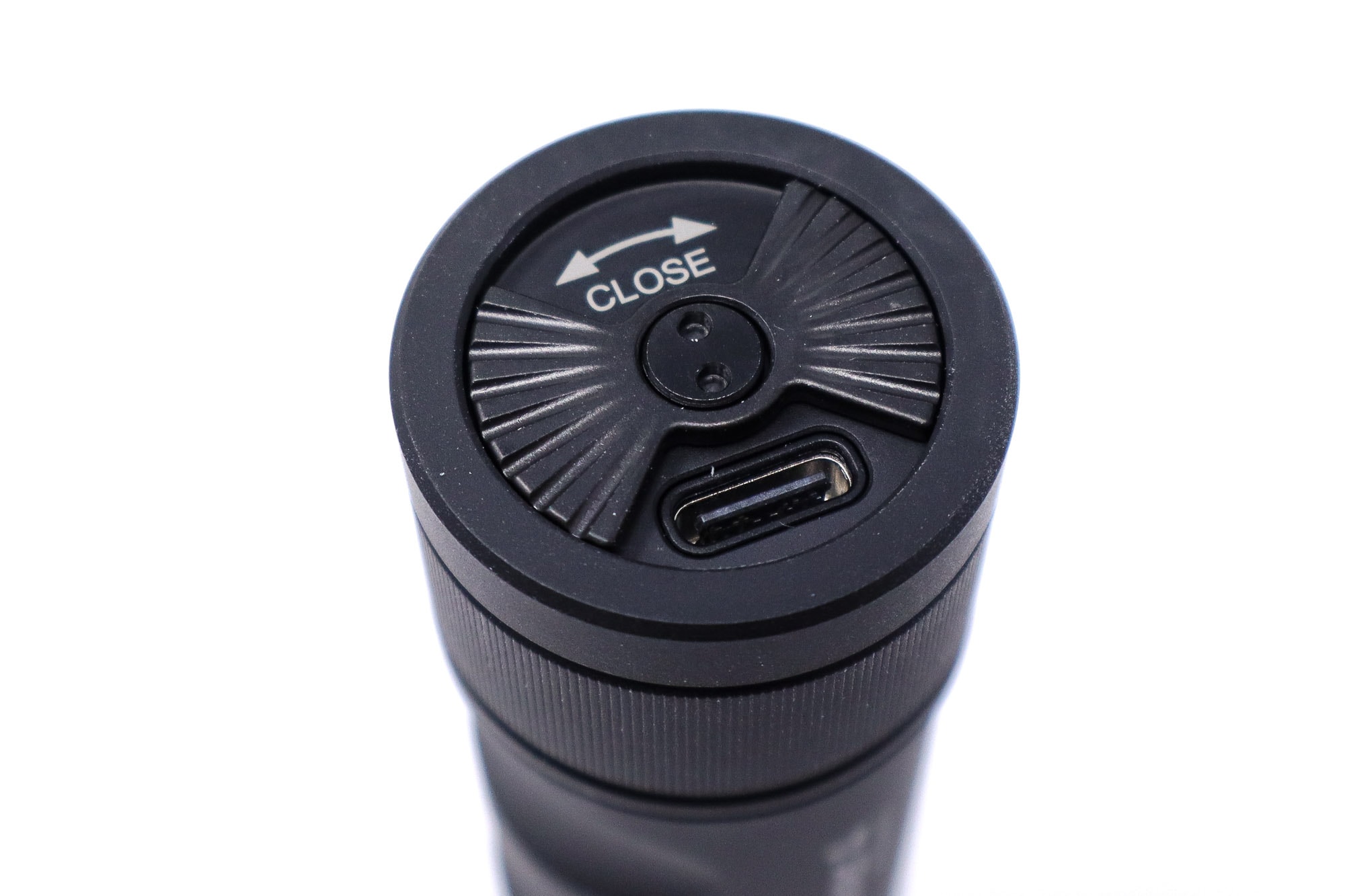
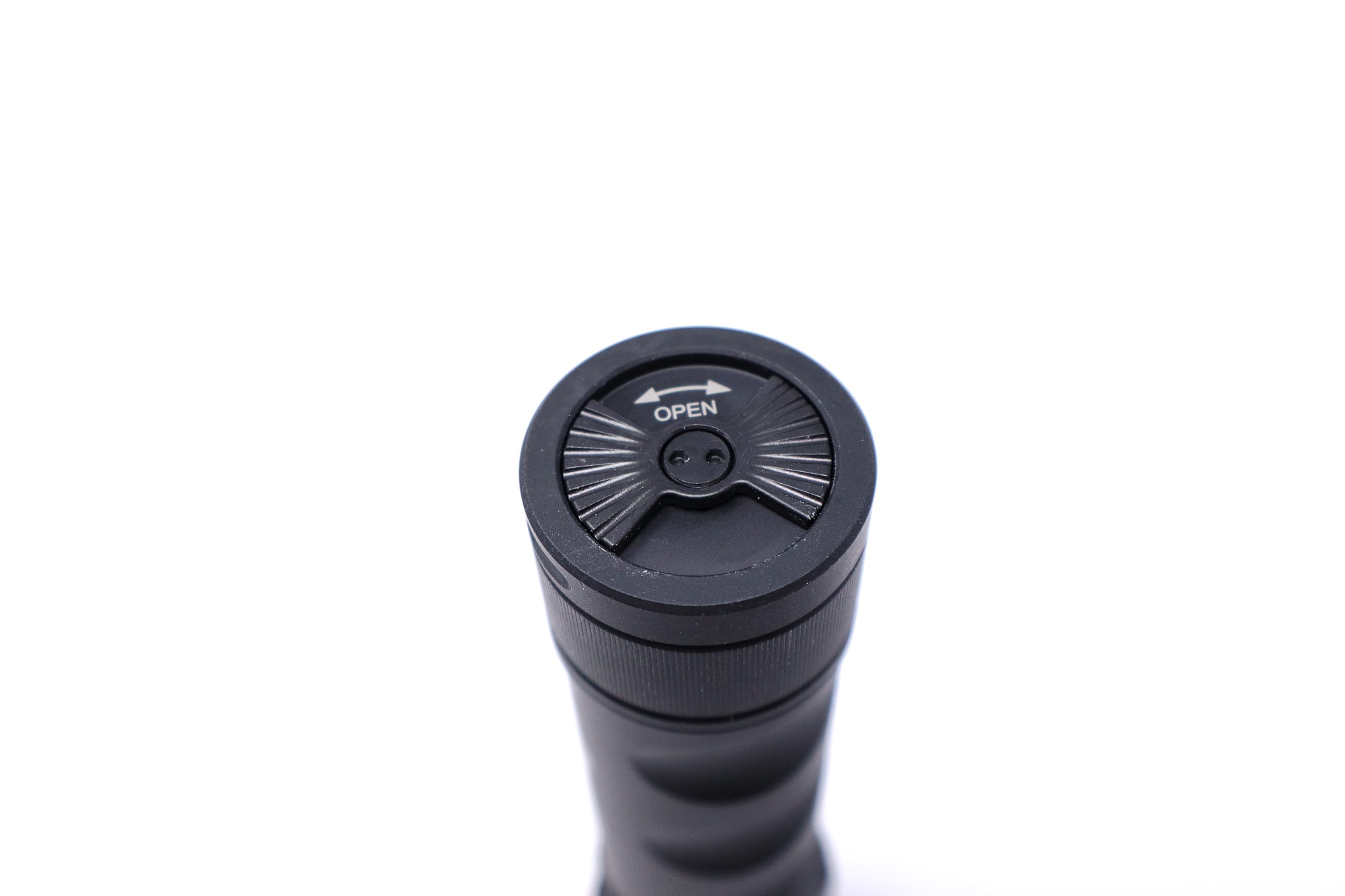
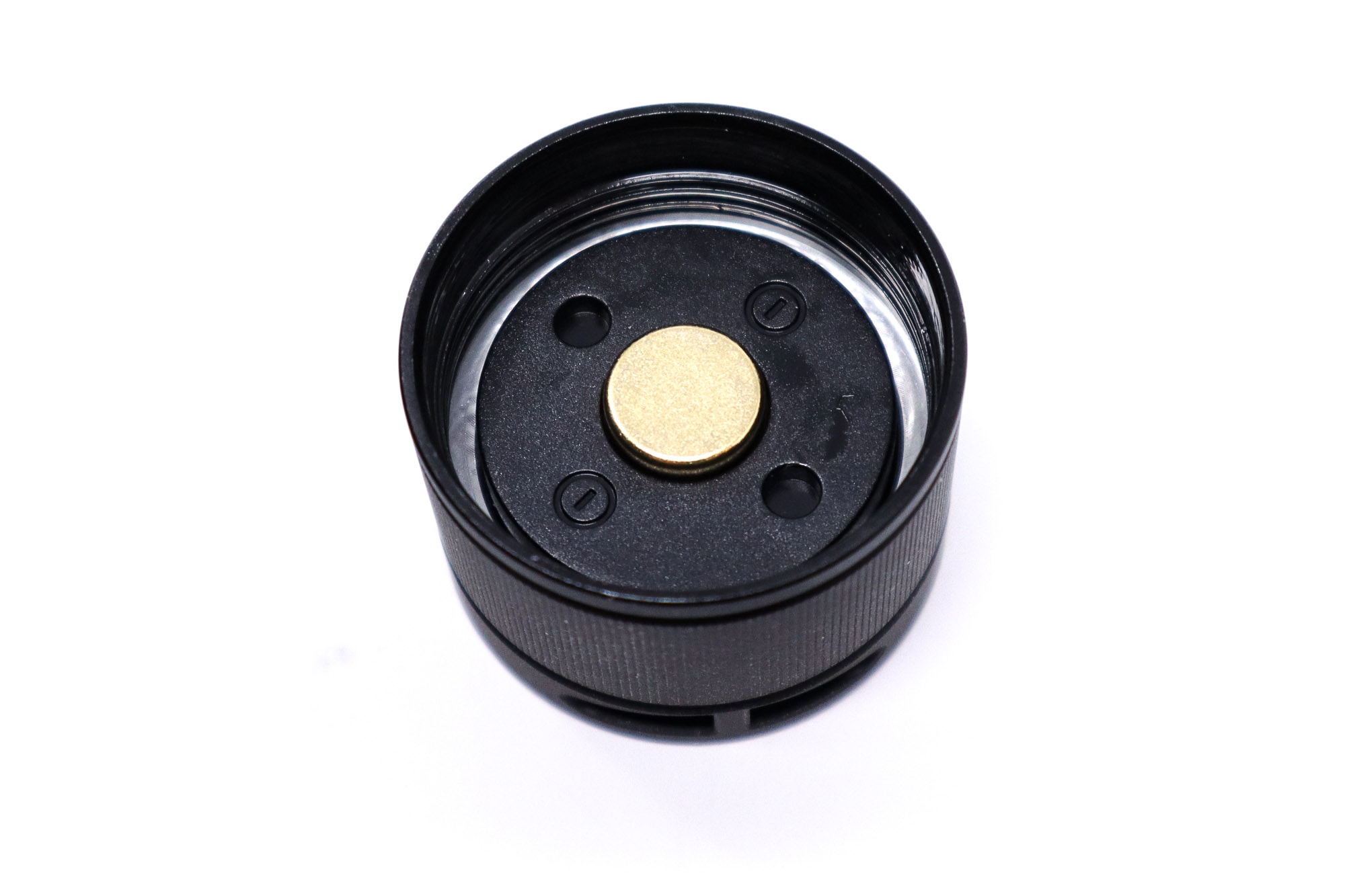
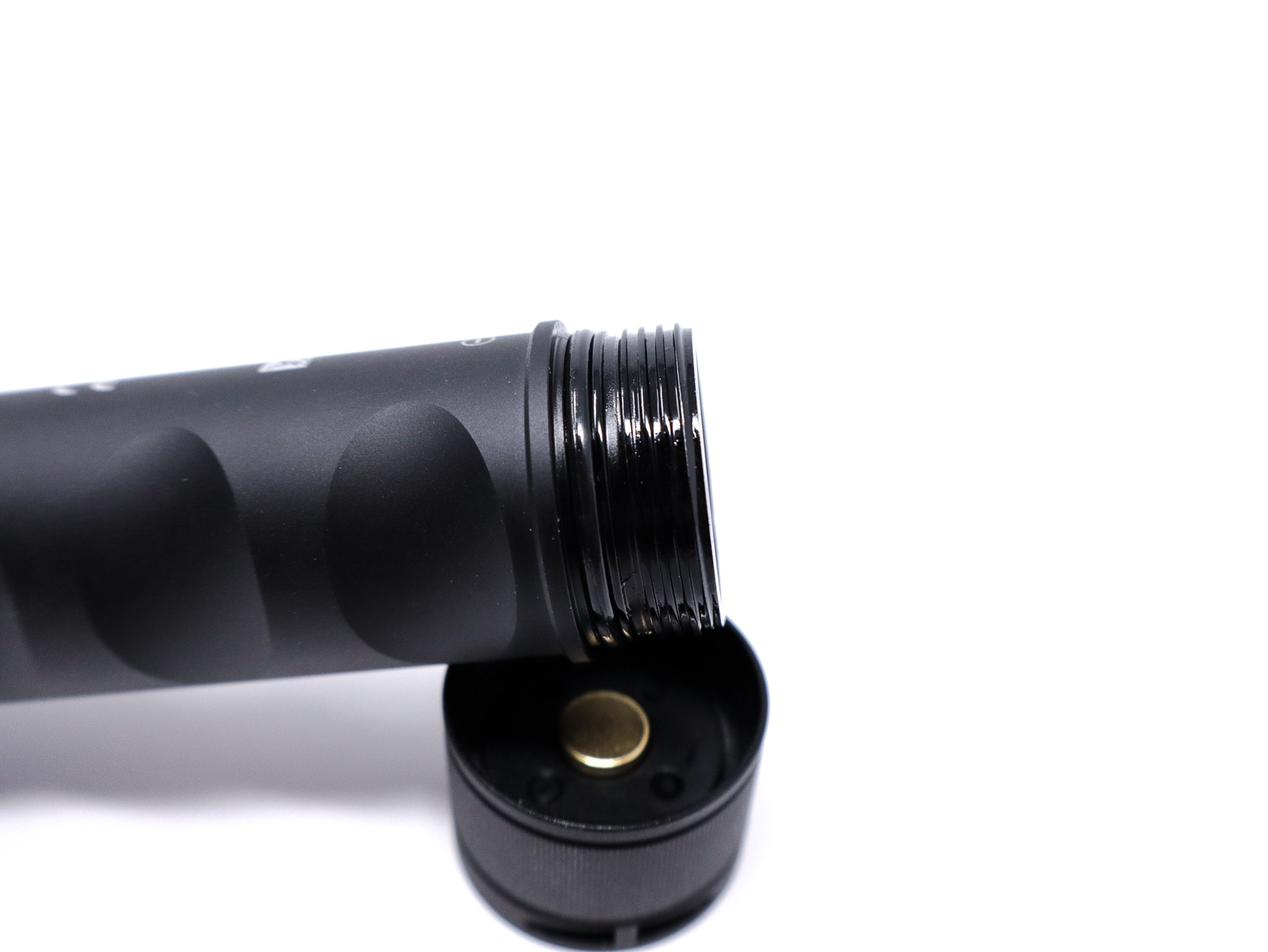
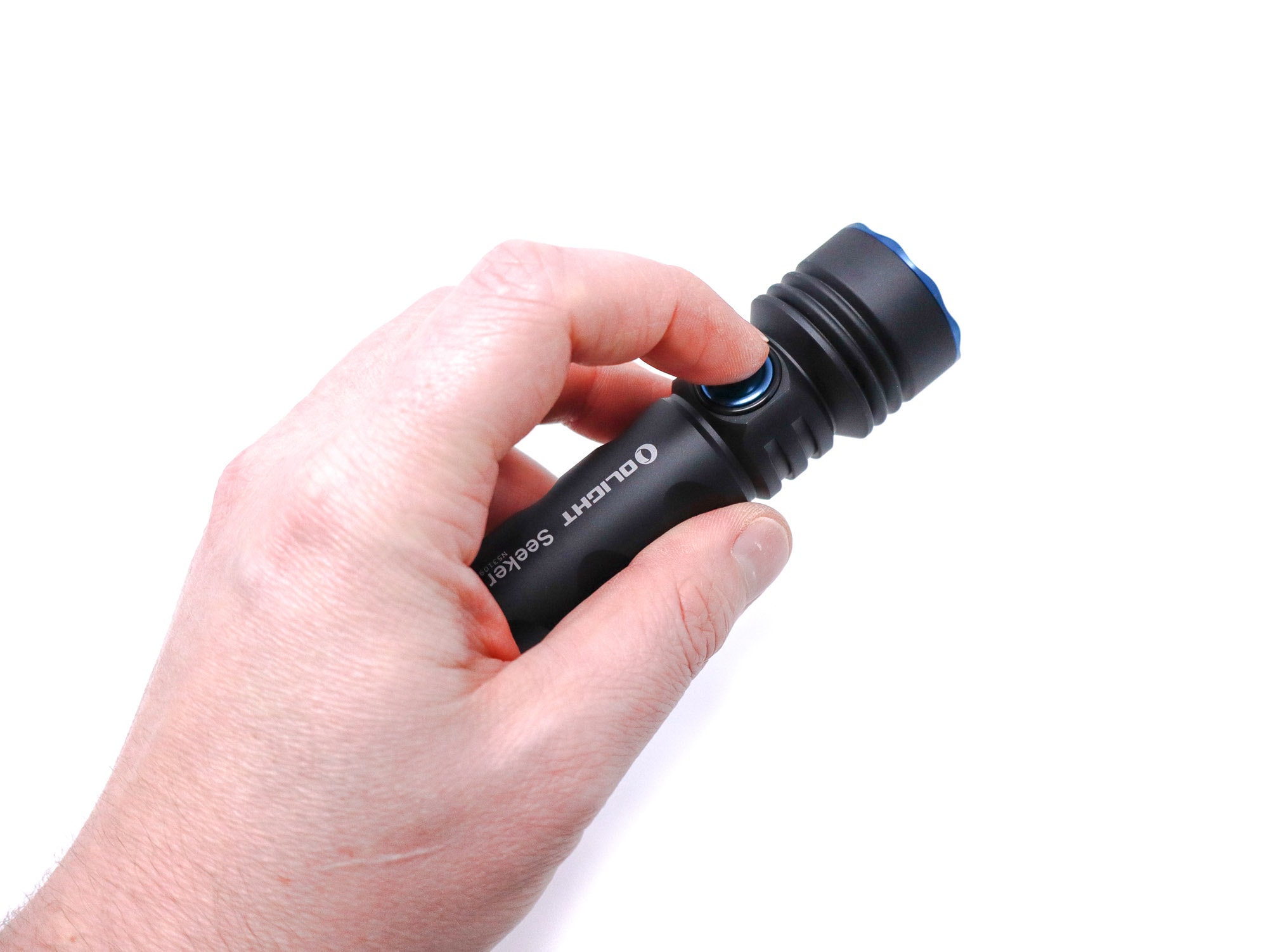
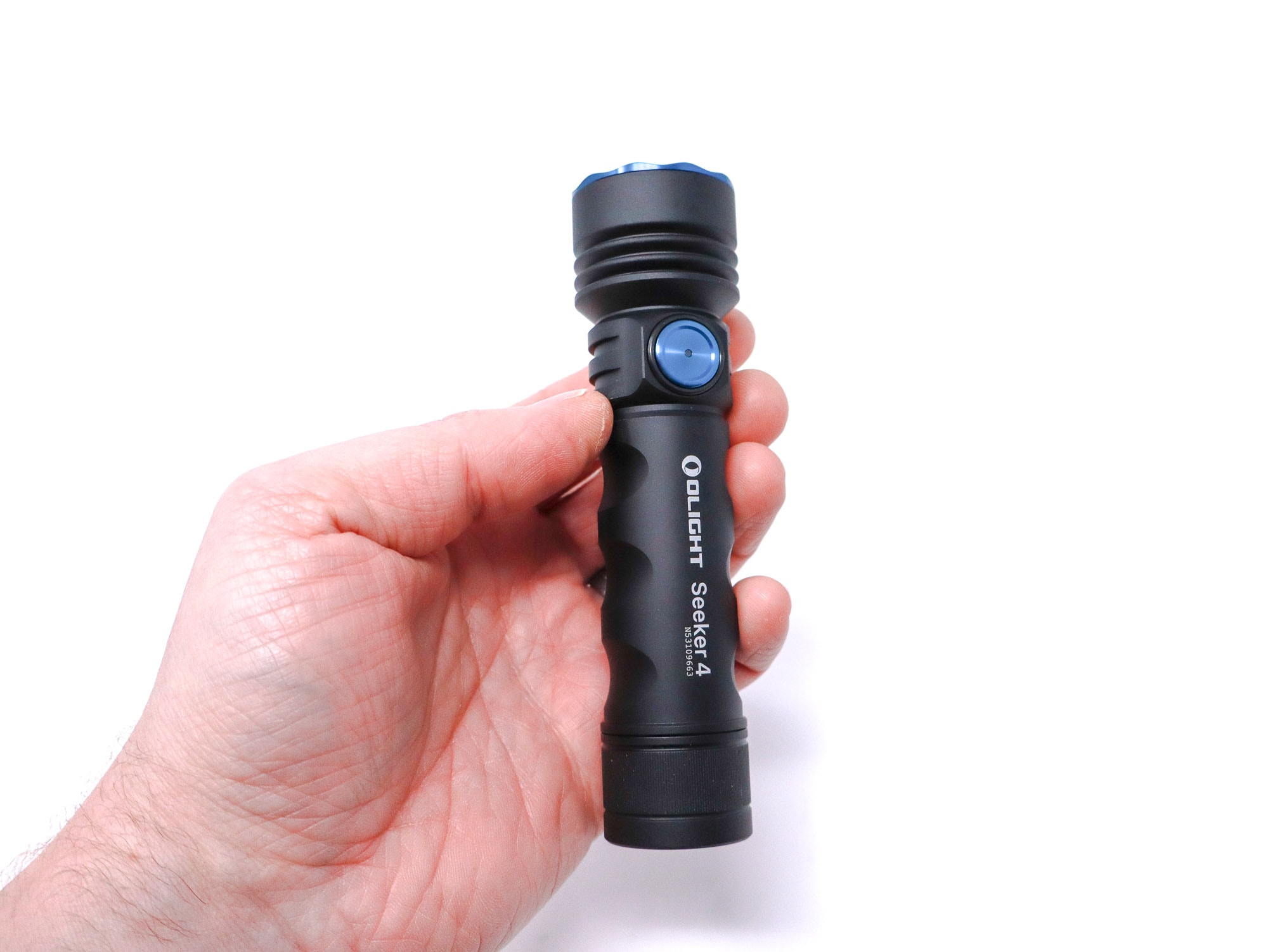
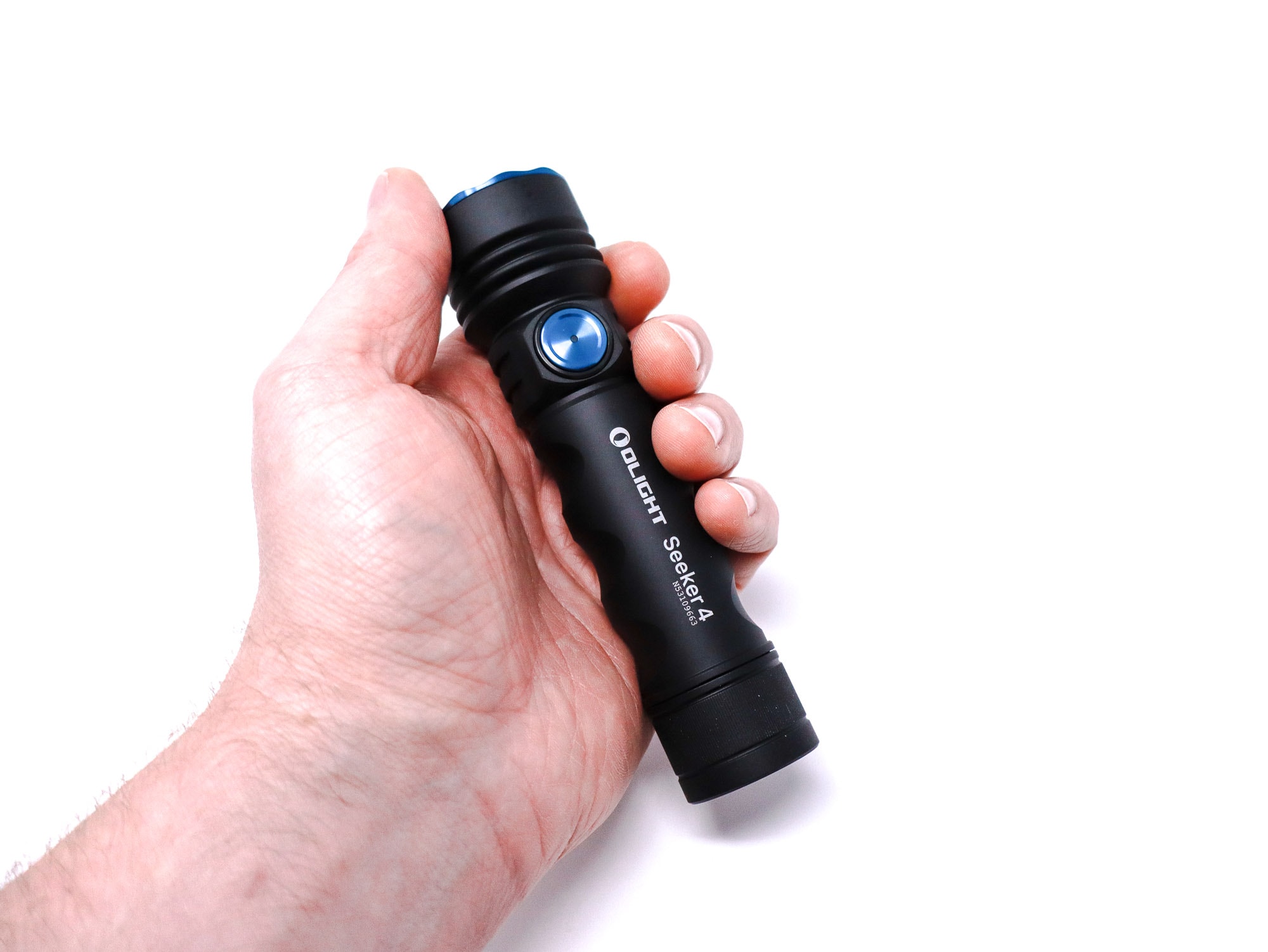
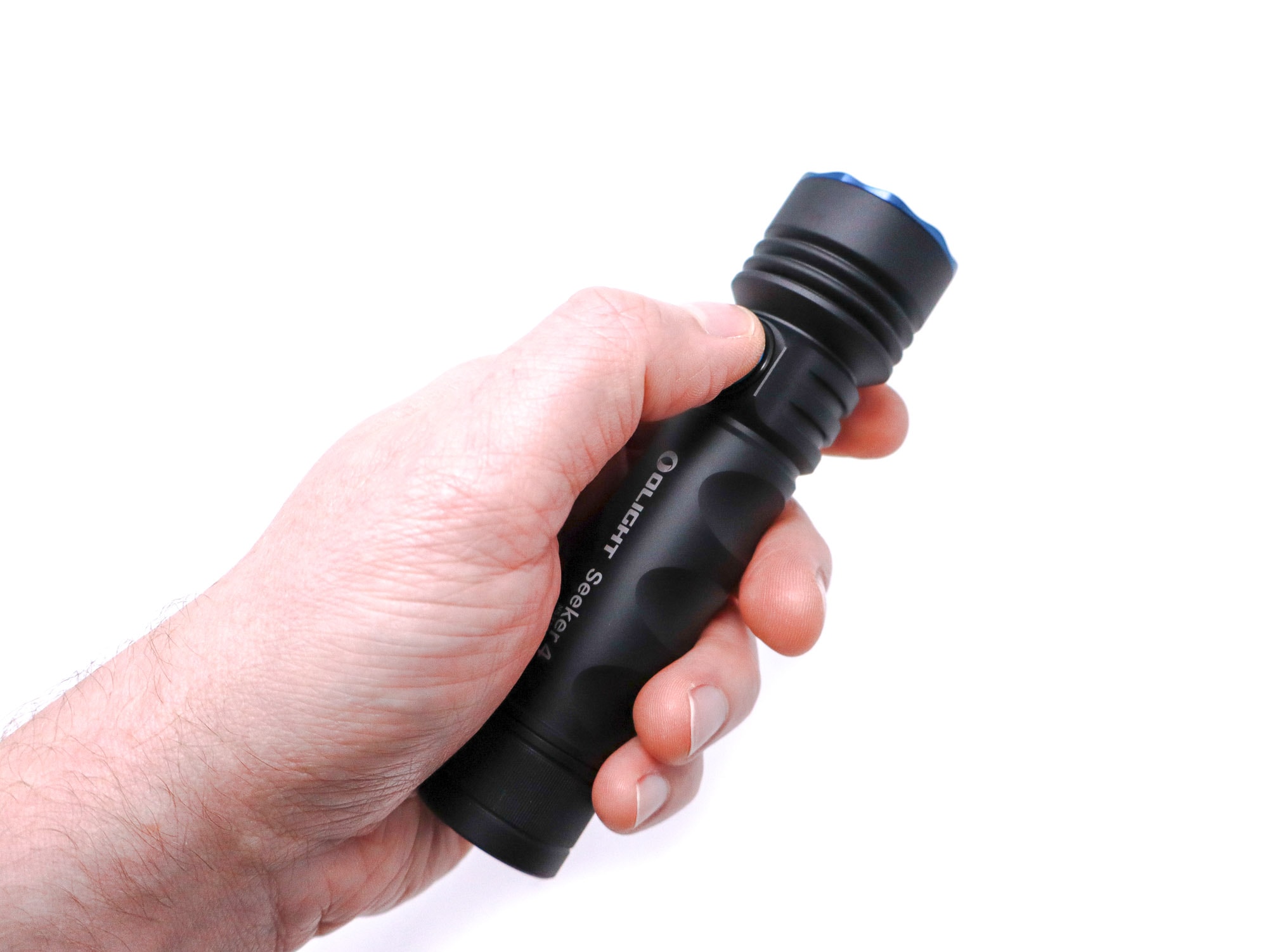
LED, Lens, Bezel, Beam, and Reflector
Okay, everyone who knows Olight knows you don’t get LED specifics. However, for the Seeker 4, Olight spills the beans. The Seeker 3 and Seeker 4 Pros are quad LED lights the Seeker 4 has a single LED, the Cree XHP50.3 HI. This LED is pretty new, and has been featured in more and more lights. It’s a domeless quad-die 5050-size LED in either 3, 6 or 12 volts. It features CSP/flip chip construction for low thermal resistance and high Lm/W for good efficiency with increased current handling.
As a domeless LED, you get higher intensity and better throw. Plus, the ugly Cree XHP rainbow has been mostly eliminated, and has a more uniform beam and tint distribution. The CCT is cool white and this one is supposed to be between 5300-6500K. The reflector is SMO (smooth) and produces good beam distance and wide, bright spill with a defined hotspot. The bezel is blue anodized aluminum or PVD coated stainless steel for style points, and it protects the AR coated (a light purple coating) mineral glass lens well.
Spectral measurements:
I used the Opple Lightmaster Pro to measure the flashlight at 1 meter from the sensor.
| Mode: | CCT: | CRI Ra: | duv |
|---|---|---|---|
| High | 5897 | 70.3 | 0.0011 |
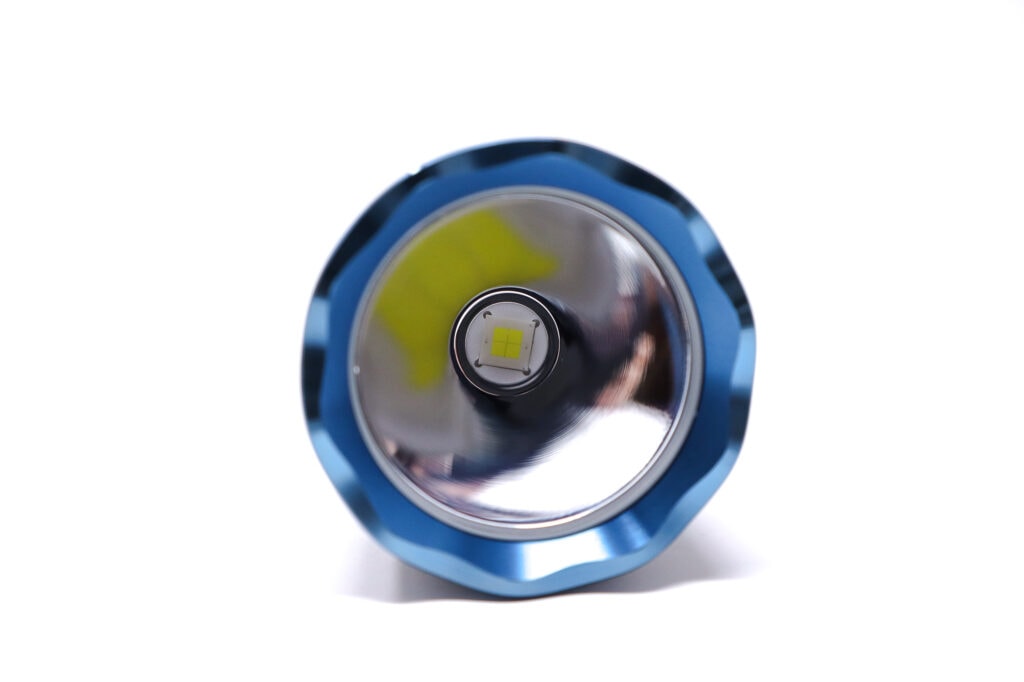
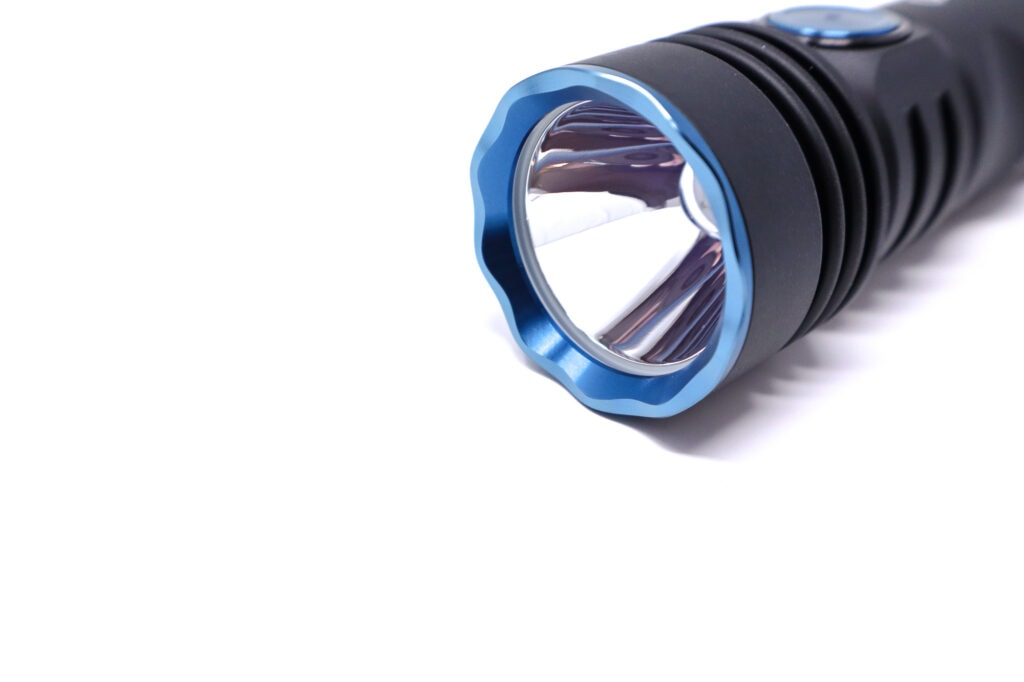
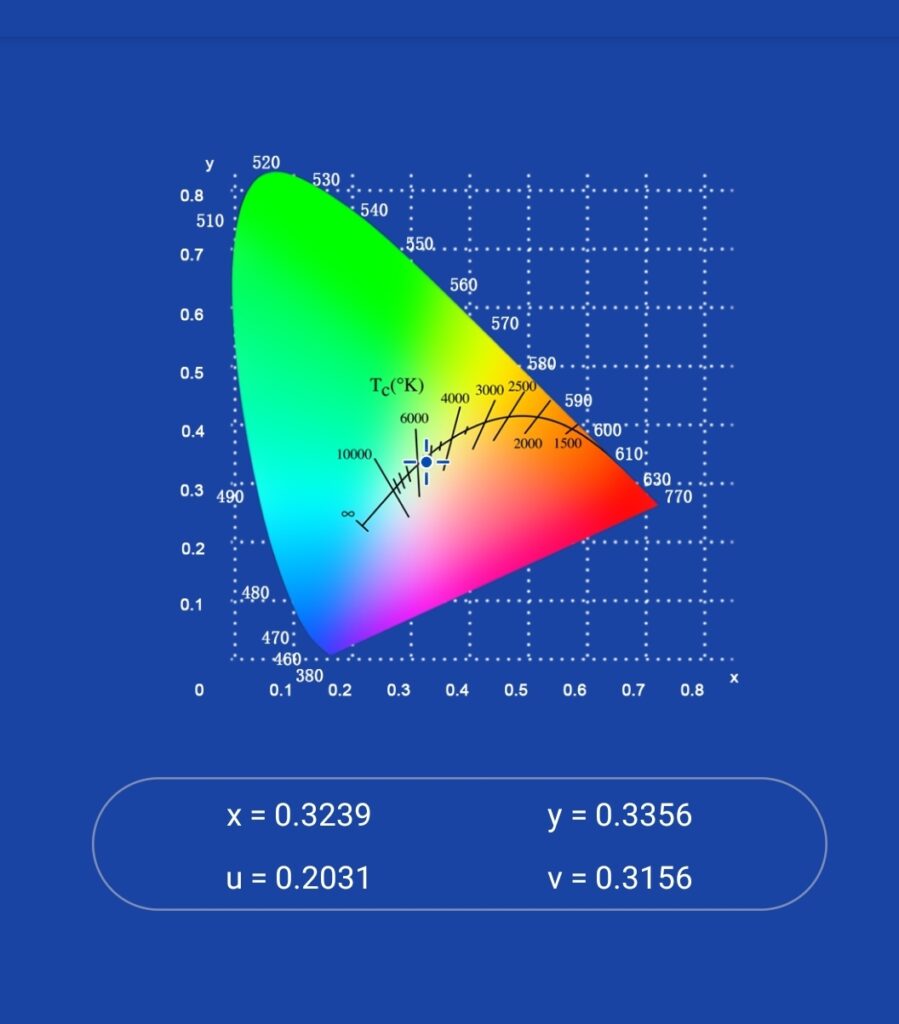
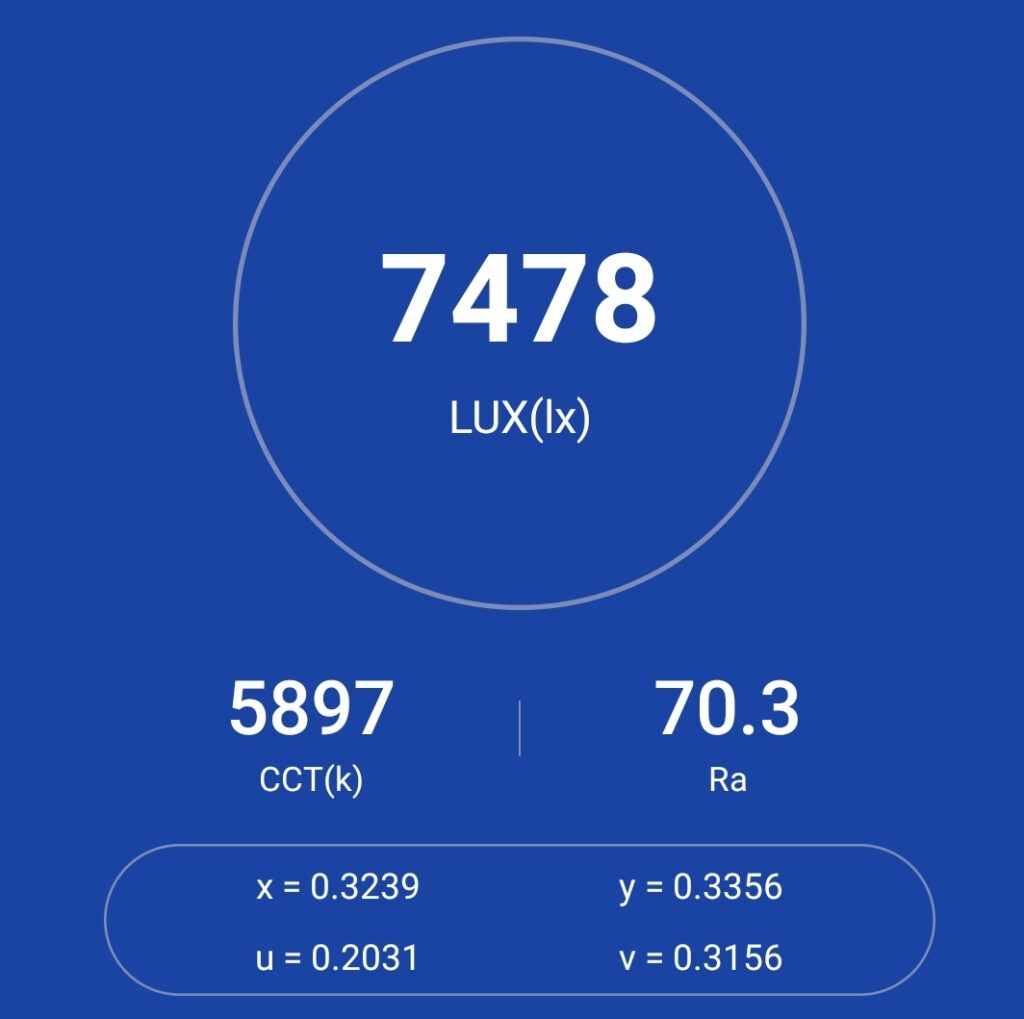
Dimensions and its competition
Dimensions:
| Olight Seeker 4 | Millimeters | Inches |
|---|---|---|
| Length | 134 mm | 5.3 in |
| Head diameter | 35 mm | 1.4 in |
Dimensions are rounded to the nearest millimeter, and to the nearest tenth of an Inch.
Weight:
| Olight Seeker 4 | Weight in grams | Weight in oz |
|---|---|---|
| Without battery: | 133 g | 4.7 oz |
| With battery | 206 g | 7.3 oz |
Weight is rounded to the nearest gram, and to the nearest tenth of an Oz.
Flashlight size comparison with its competition:
Group 1 left to right: Acebeam E75, Olight Seeker 4, Thorfire C8, Astrolux EA01
Group 2 left to right: Thrunite T2, Olight Seeker 4, Emisar D1 v2, Armytek Prime C2 Pro Max Magnet USB, Acebeam P17 Defender
Group 3 left to right: Olight Warrior 3S Limited Edition Ti, Olight Seeker 4, Olight Warrior X4
Group 4 Olight flashlights, reflectors left to right: Olight Warrior X4, Olight Seeker 4, Armytek Prime C2 Pro Max, Thorfire C8
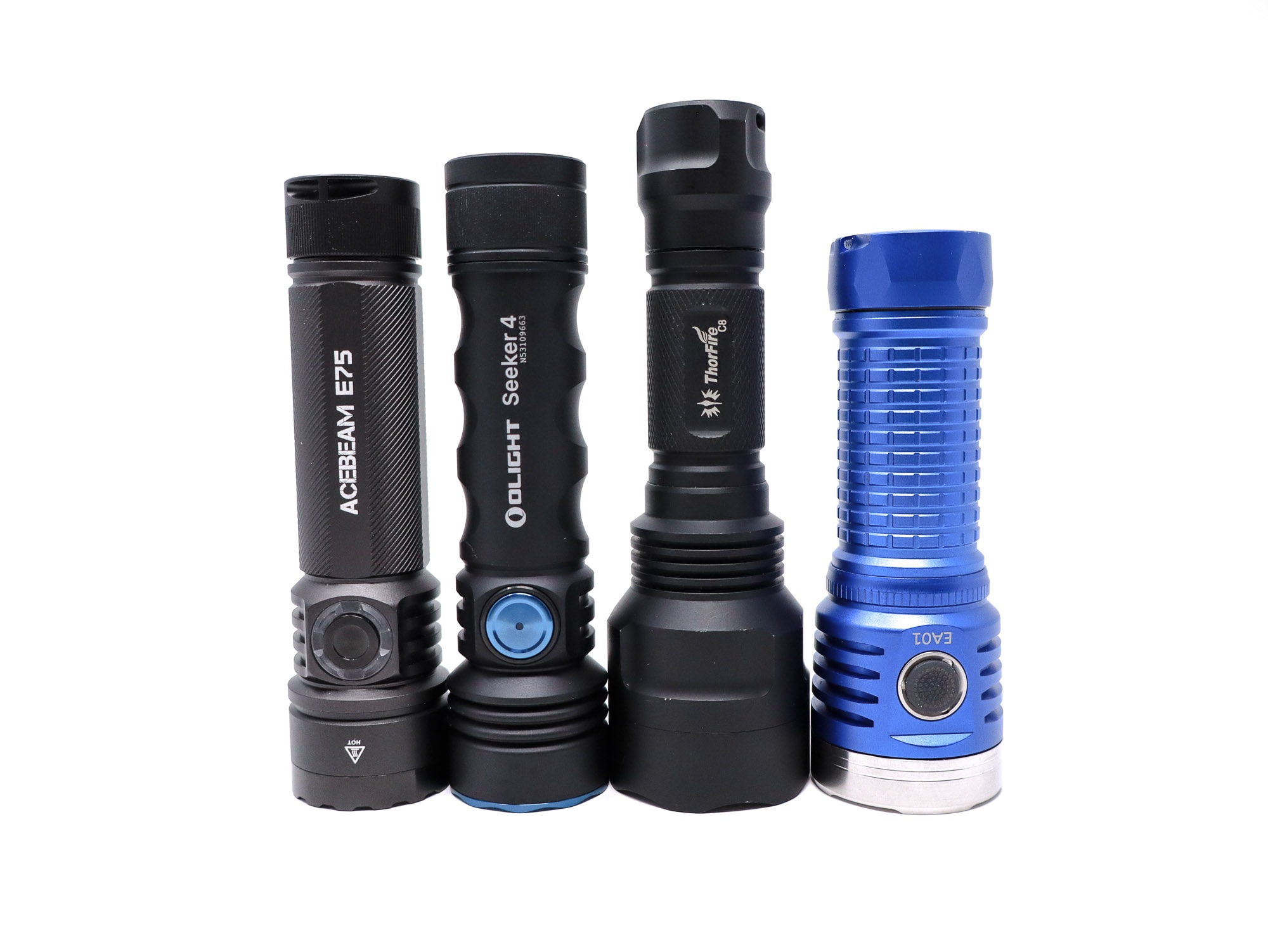
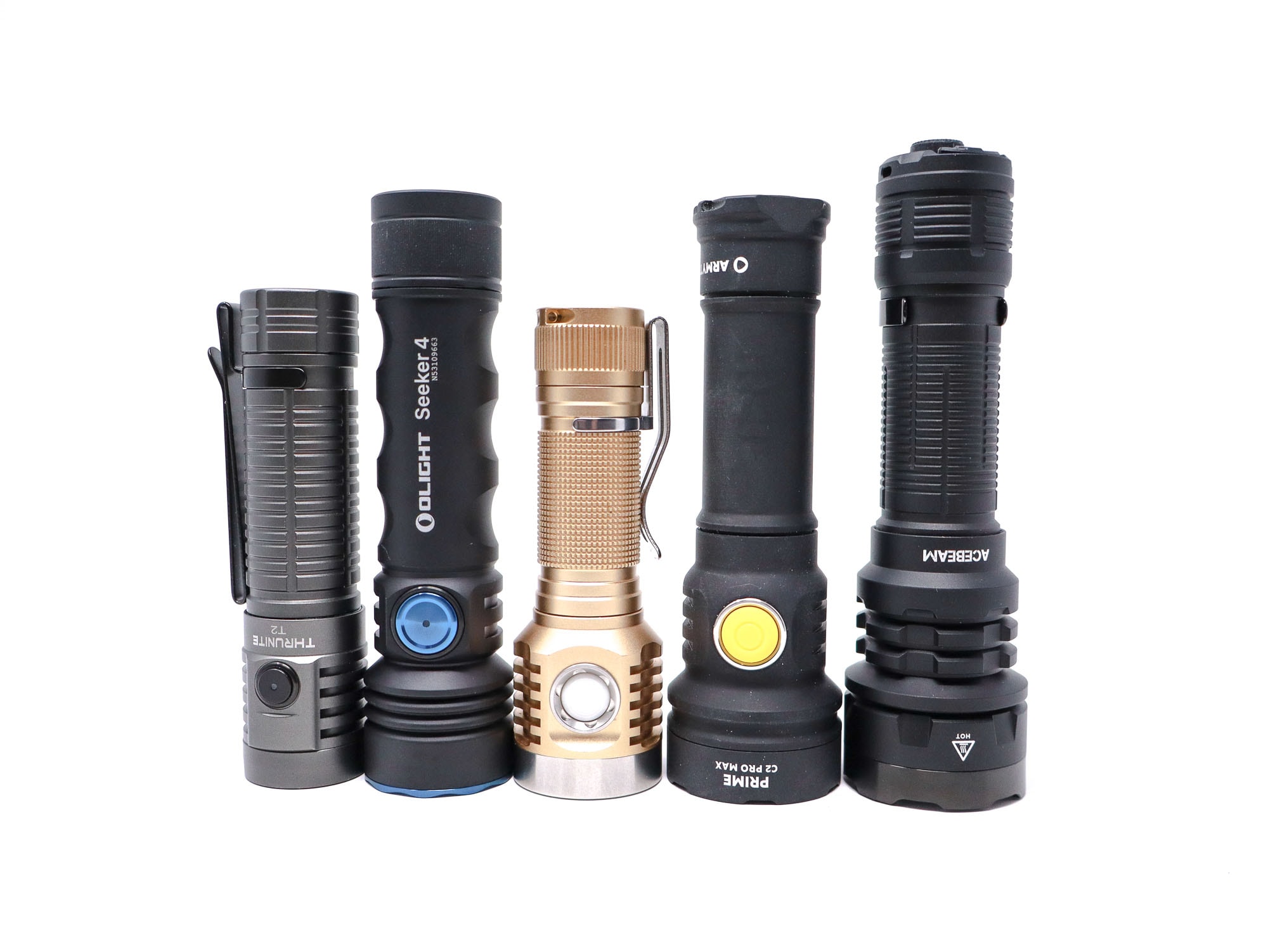
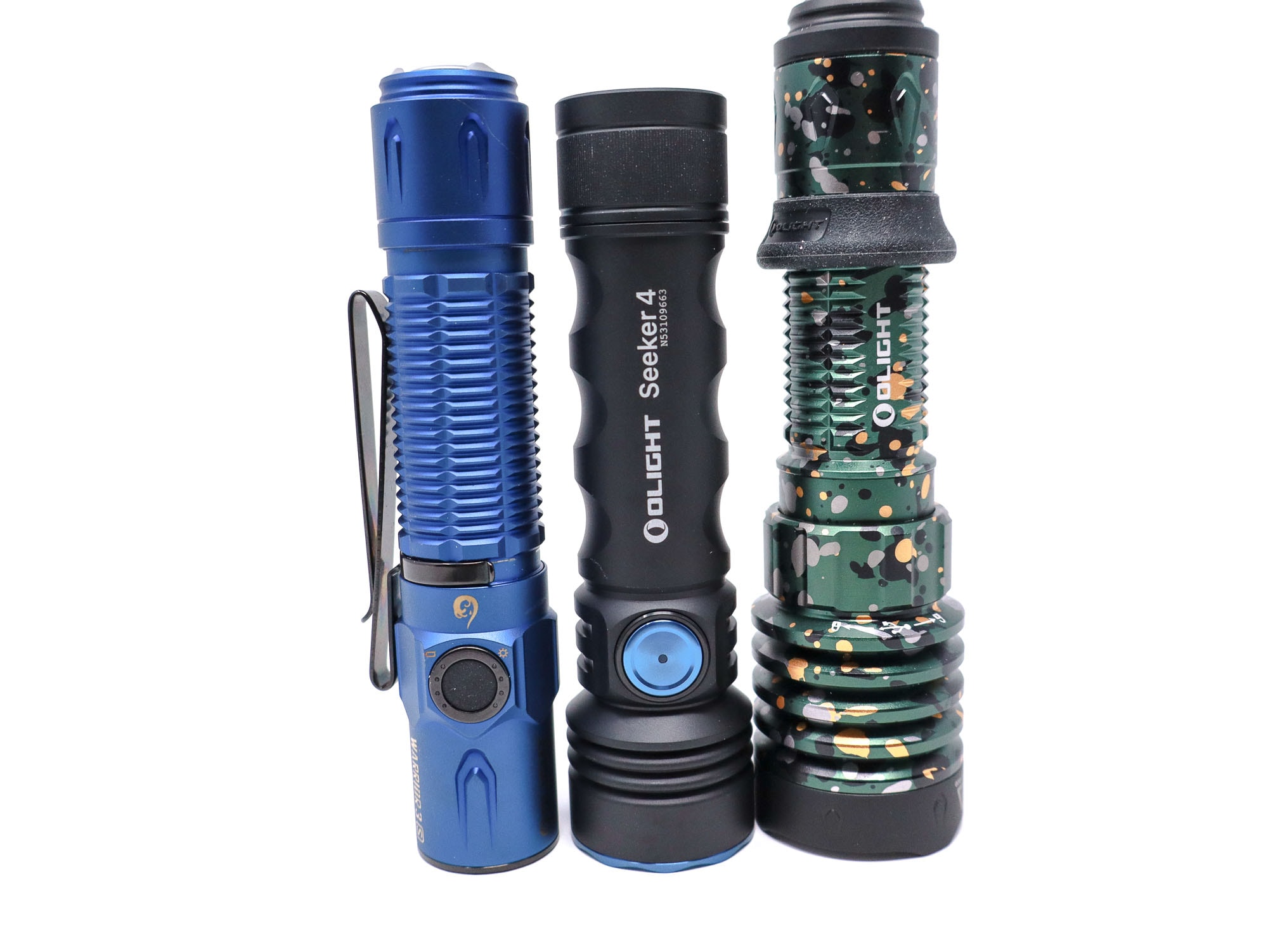
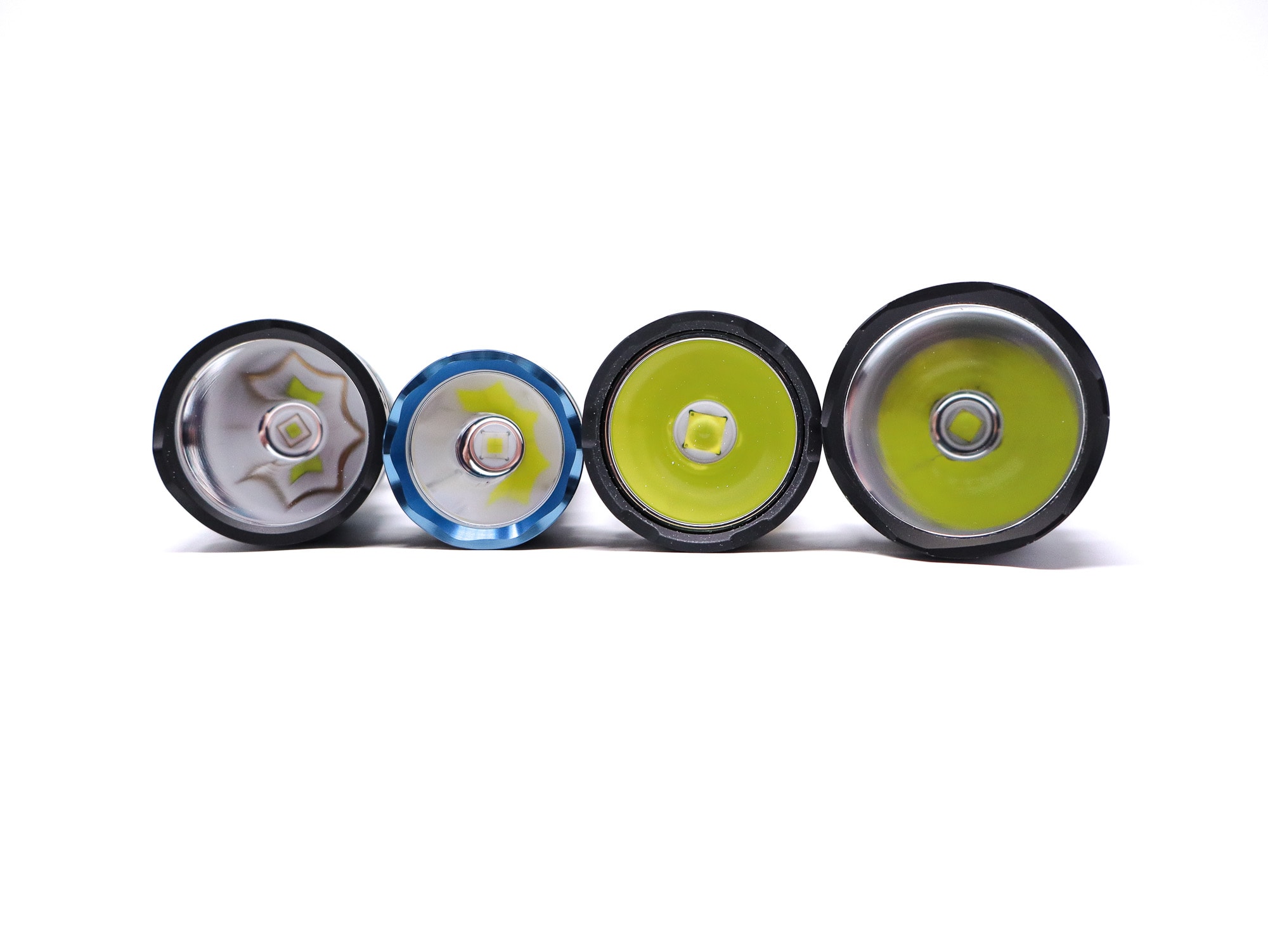
Olight Seeker 4 UI: User Interface and Driver
The driver is not mentioned, but typical of Olight, it’s going to be a boost or buck driver since the 50.3 HI needs either 3 or 6 volts input and a single li-ion is 4.2 volts fully charged. Boost/buck drivers are awesome since they’re constant current and the output doesn’t decrease as the battery drains like a FET driver. As long as the battery supplies voltage needed to keep the MCUs running, the output is laminar.
The UI is similar to the other single switch Seekers with 4 nicely-spaced modes, a Moonlight, and a single Strobe.
Available modes:
- Moonlight, Low, Medium, High, Turbo
Available blinky modes:
- 13 Hz Strobe
From OFF:
- Single click: Turns on in last mode
- Press and hold switch: Moonlight mode
- Double click switch: Turbo
- Triple click switch: Strobe
From ON:
- Single click: Turns off
- Press and hold switch: Cycles through modes L-M-H-L
- Double click: Turbo
- Triple click: Strobe
Mode memory:
- Last mode memory for modes L, M, H. Turbo and Moonlight are not memorized. If switching off from Turbo mode, the light restarts in High mode. High mode is only memorized for 1 minute after switching off.
Shortcuts:
- Press and hold from off: Moonlight mode
- Double click: Turbo
- Triple click: Strobe
Low voltage warning/protection:
- The switch LED indicated battery state when turned on:
- Solid green >60%,
- solid orange 10% to 60%,
- solid red 5% to 10%,
- blinking red <5% remaining
Strobe/blinkies
- 13 Hz Strobe, activates with a triple click.
Lock-out mode:
- Yes, electronic lockout or manual lockout. From off, press and hold the switch for +2 seconds. The light goes into Moonlight, then turn off to acknowledge the lockout. The switch LED turns on if the switch is pressed during lockout. Press and hold the switch +1 second to turn the light on in Moonlight and unlock. To manually lock, unscrew the tailcap ½ turn.
Auto shut off Timer:
- The UI incorporates an auto shutoff timer that will automatically turn the light off if left on for 3 (short) or 9 (long) minutes. To configure the timer, from on, double click and hold the switch. The light blinks once for the short timer and twice for the long timer. The light will stay on and shut off when the timer reaches the set time.The light will remember the last timer setting the next time.
PWM
- None visible by eye
Additional/summary info on the UI:
- I really like the UI, and no complaints at all. It does what it’s supposed to without drama or finaggling or programming. It’s a simple click it on, click it off, press and hold for mode changes. The mode switching speed is great, not too slow, not too brisk, and the mode spacing is fine. This is exactly the type of UI I’d unhesitantly give to someone who’s using a high power light for the first time. This is part of Olight’s success: Keep it simple! I’m not a huge fan of timers, and don’t really have a need for it, but it might be useful if you only need 3 or 9 minutes of light.
Olight Seeker 4 Charging and batteries
The Seeker 4 adopts the same single 21700 li-ion battery configuration as the other Seekers. Olight includes their excellent ORB-217C50 21700 battery. It’s a 5000 mAh ‘customized’ (proprietary) battery and is protected with a PCB. I know, proprietary batteries are not ideal, but they’re here to stay, and I’m not too bothered. However, unlike the other Seekers, the Seeker 4 now has onboard USB type C charging like the Warrior X4, and there’s no provisions for the MCC system.
There’s nothing wrong with the MCC system, but you’re stuck with it, and no alternative for charging other than shoehorning the cell into your hobby charger. Olight doesn’t recommend it-clearly labeled on the cell, and no, I don’t recommend it, but it will charge if it fits. The cell fits in my VapCell S4+ (version 2).
The USB type C port is also done right: It’s hidden under a rotating shroud on the back of the tailcap, which is nice because this is a superior design to a rubber flap. It’s well protected and won’t open unintentionally, and is far more durable. Olight says the charging is set to 2 amps, and a discharged battery on USB A to C and C to C charged at 5 volts and 1.7 amps.
| Charge type | Fits | No fit | Charge time |
|---|---|---|---|
| USB type C | Included cell only | Any non-proprietary cell | Around 3.5 hours |
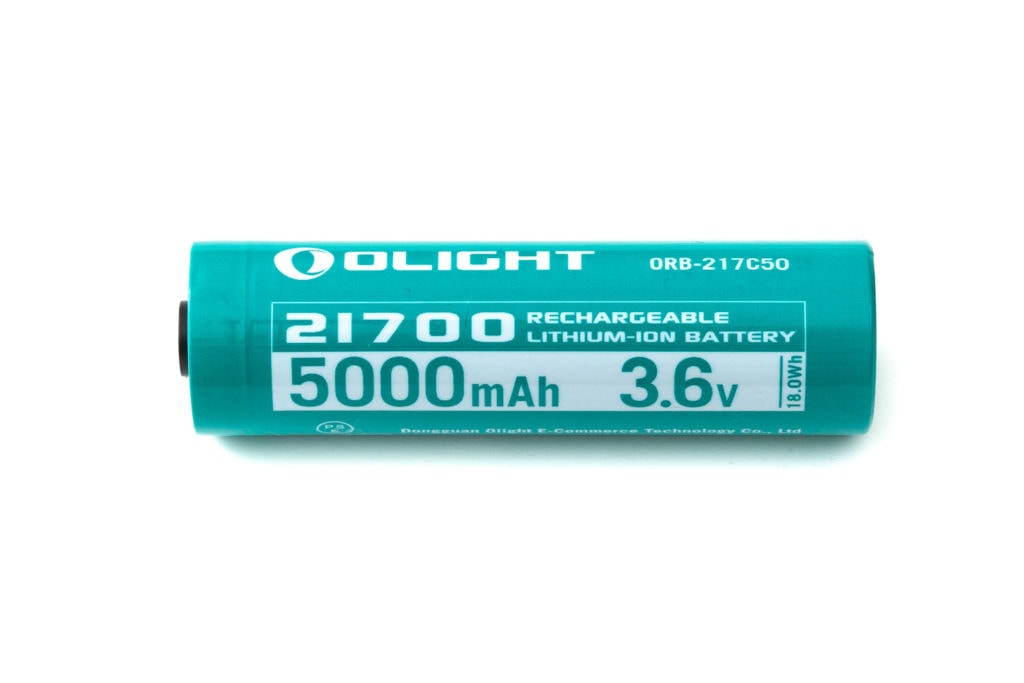
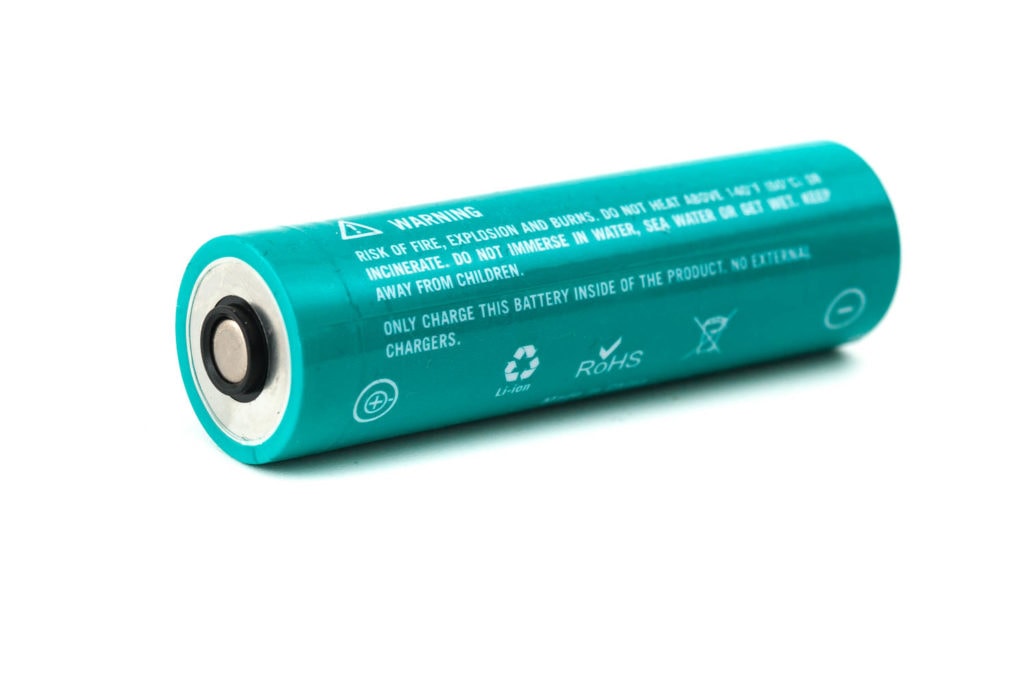
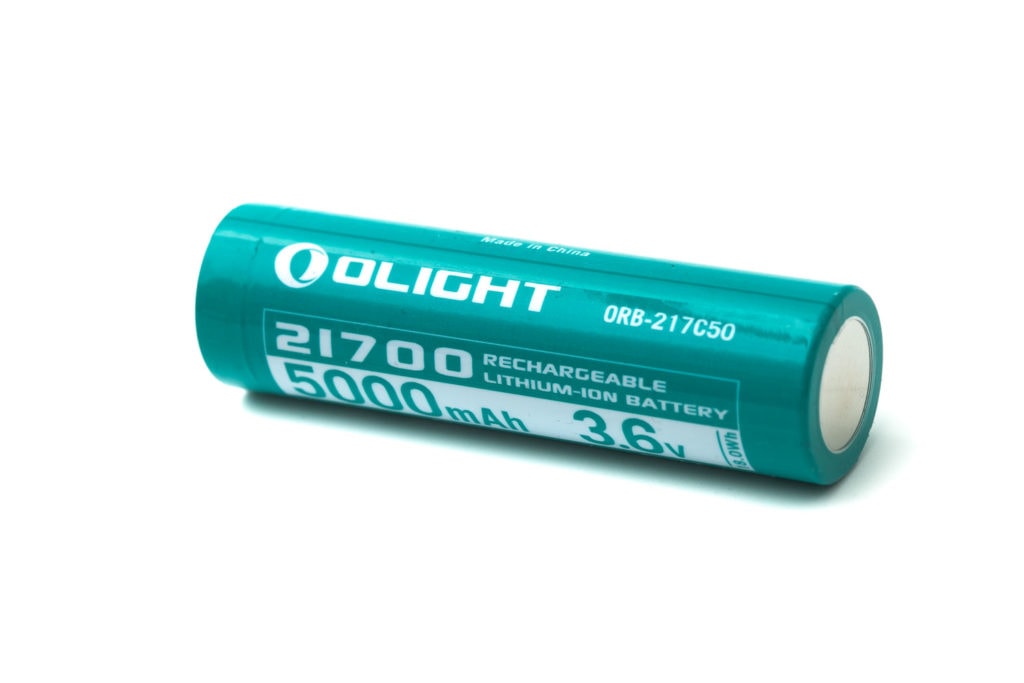

Performance test
Lumen measurements
How Lumens are Measured: Understanding ANSI FL1 Standards How Lumens are Measured: Understanding ANSI FL1 Standards: The ANSI FL1 standards specify that output in lumens should be measured 30 seconds after turning on, as this is the standardized time for measuring brightness according to the industry standard. This is why we focus on this part in our measurements. The ANSI FL1 standards require an ambient temperature of 22 ± 3°C. We record the ambient the ambient temperature to identify potential reasons for any observed discrepancies.Lumens are measured in my 30 cm integrating sphere with a Digi-Sense 20250-00 data logging luxmeter. The sphere has been calibrated with a Convoy S2+ measured to 260 Lumens and the figures are within 10% of actual. No current measurements (aside from the standby current…which was a bad idea!). Measurements were taken using the included fully charged ORB-217C50 5000 mAh 21700.
| Mode | Specs | @turn on | @30 sec | @10 minutes |
|---|---|---|---|---|
| Moonlight | 5 | 4.5 lm | 4.5 lm | – |
| Low | 50 | 47 lm | 47 lm | – |
| Medium | 300 | 306 lm | 306 lm | 306 lm |
| High | 1200 | 1251 lm | 1251 lm | 1206 lm |
| Turbo | 3100 | 3168 lm | 3186 lm | 810 lm |
Parasitic drain:
- 27.2 µA
Whoops! Testing the parasitic draw on the light damaged the driver which killed Turbo mode, plus it wouldn’t charge anymore. Olight sent out a replacement so I could finish the testing, so a huge thanks to them, but the lesson here is not all lights like being tested for quiescent current, so do it at your own risk.
The outputs track the factory specs nicely! Typical Olight stuff here. I’m coming in on the nose as far as ANSI is concerned and higher at turn-on. Great numbers for a relatively compact flashlight.
Olight Seeker 4 Battery Life: Runtime graphs
How Runtimes are Measured: Understanding ANSI FL1 Standards About ANSI FL1 runtime standards: The runtime is measured until the light drops to 10% of its initial output (30 seconds after turning on). This does not mean that the flashlight is not usable anymore. The last column shows how long the light actually works till it shuts off. If there is a + symbol, it means that the test was stopped at that particular point, but the light was actually still running. This happens on certain occasions, with certain drivers, firmware, or batteries.Lumens are measured in my 30 cm integrating sphere with a Digi-Sense 20250-00 data logging luxmeter. The sphere has been calibrated with a Convoy S2+ measured to 260 Lumens and the figures are within 10% of actual. I use a Digi-Sense 20250-92 data logging thermocouple for the temperature measurements. The probe is affixed to the head using kapton tape and uses the same 5 second sampling rate for logging. I used the included, fully charged ORB-217C50 5000 mAh 21700.
| Mode | Specified runtime | Measured runtime ANSI | Time till shut off |
|---|---|---|---|
| Medium | 8h 50m | 8h 29m | 8h 29m |
| High | 4h 16m (total) | 4h 29m | 4h 29m |
| Turbo | 2h 42m (total) | 2h 34m | 3h 16m |
No issues with the runtimes, and my results pretty much track (again) Olight’s figures. I really like to see this from flashlights because it shows they’ve been exhaustively tested in the lab before shipping with the numbers to back it up. The outputs are laminar, as expected from the boost/buck driver, and we have excellent thermal regulation and sustained outputs. The light never got too hot to handle, with the temps staying around 50 C at the head. You get a lot of light for a long time here. The light was inoperable after the shut down, with the end voltage reading between 2.8 and 2.97.
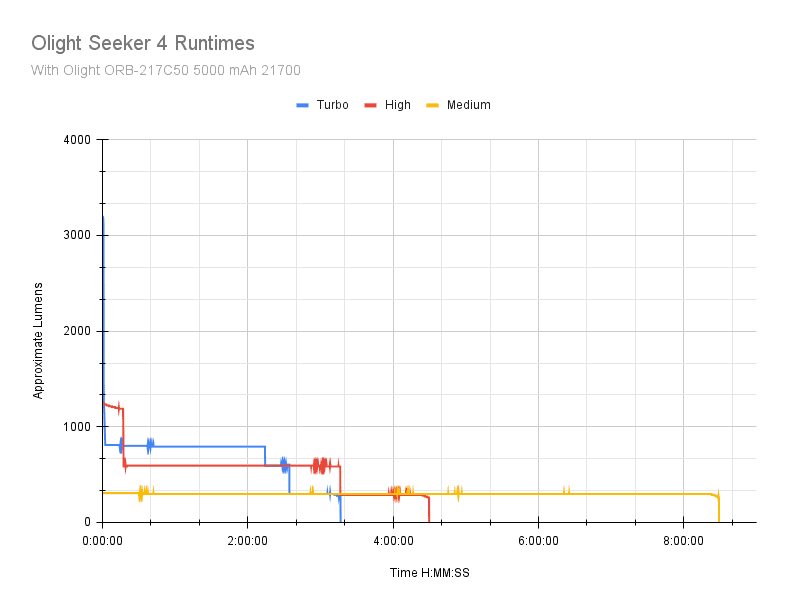
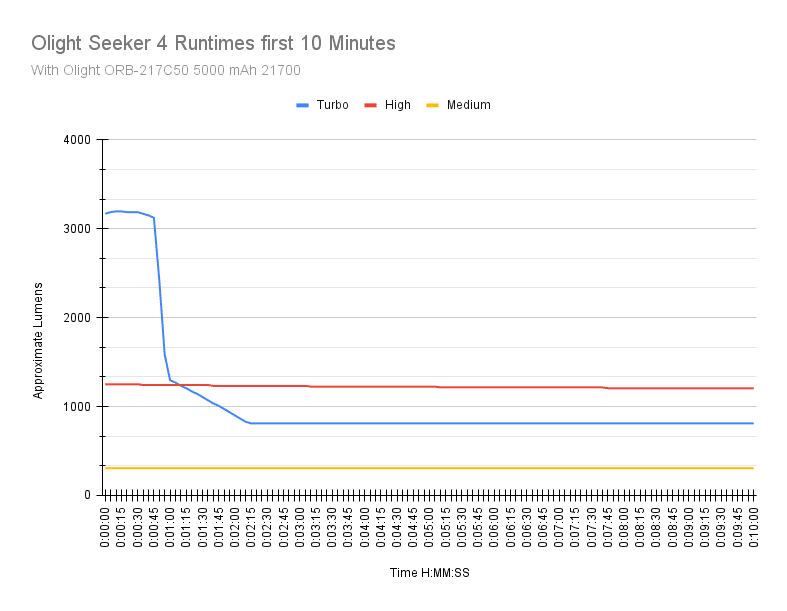
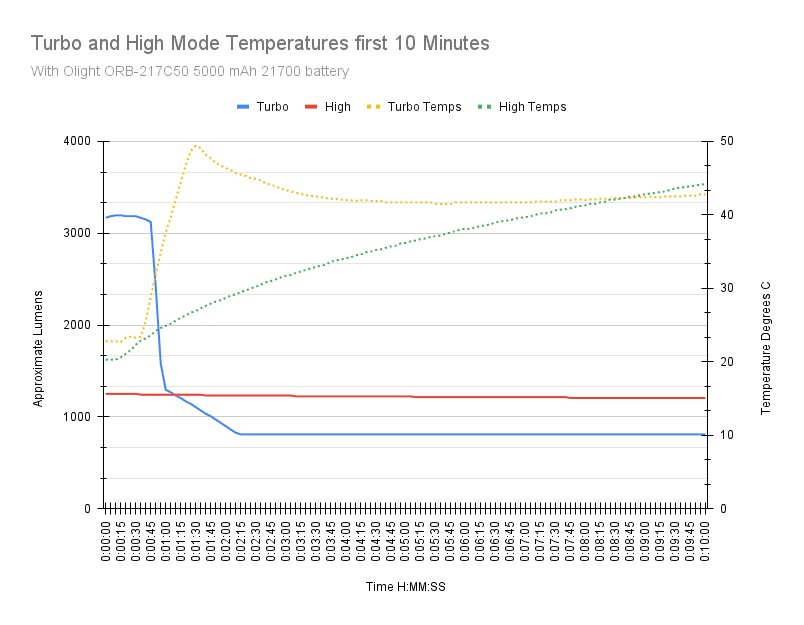

The comparison graph includes some comparable lights with single cells and either quad LEDs or single quad die LEDs. While it lags behind the boost-driven P17, E75, and TC20 V2 for max and sustained output, the Seeker 4 holds output for longer. The other lights on Turbo have much shorter runtimes.
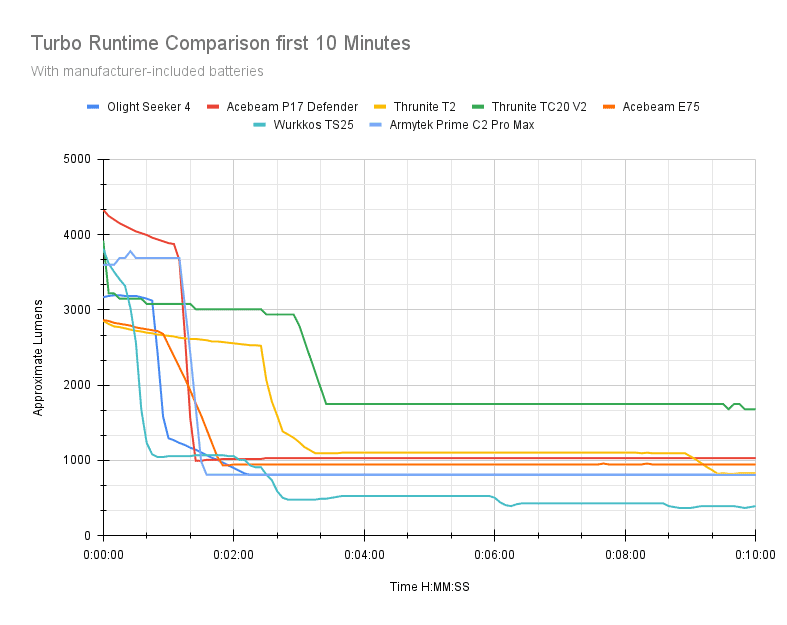

Peak beam intensity and beam distance measurements
About Peak beam intensity: Understanding ANSI FL1 Standards About peak beam intensity The calculated value of distance in meters at which the flashlight produces a light intensity of 0.25 lux. (0.25 lux is about the brightness of a full moon shining on an object). This means that the intensity has decreased so much, it becomes difficult to see darker objects, or objects that don’t reflect light. The columns ‘Meters’ and ‘Yards’ use rounded numbers.Beam distances are measured using a Uni-T UT383S luxmeter measured indoors at 5 meters using the included fully charged ORB-2150C 5000 mAh 21700. Measurements taken at 30 seconds.
| Mode | Specs | Candela measured | Meters | Yards |
|---|---|---|---|---|
| Moonlight | ? | 75 cd | 17 | 19 |
| Low | ? | 600 cd | 49 | 54 |
| Medium | ? | 3800 cd | 123 | 134 |
| High | ? | 15,800 cd | 251 | 274 |
| Turbo | 40,260 | 43,600 cd | 418 | 457 |
The beam distance and intensity figures also track the Olight specs. This is really good beam distance for a sub 40 mm head flashlight with a high power LED. The turn-on spec is actually lower than the 30 second figure (40,350 cd) since the output ramps up a bit from start.
Beamshots
Camera settings and distance: Photos taken with a Canon EOS R100 with Canon RF-S 18-45 mm STM lens. The camera is set to ISO, 0.3s, F4.5, ISO 800, and 5000K WB. The fence is 40 meters distant.
Beamshots of the following flashlights compared:
- Olight Seeker 4
- Olight Warrior X4
- Astrolux EA01
- Thrunite TC20 V2
- Thrunite T2
- Wurkkos TS25
- Acebeam E75
- Acebeam P17 Defender
Please note that the following beamshots are mainly intended to showcase the beam pattern and beam quality, rather than overall performance. These images are typically taken directly after activation, and in different seasons or weather conditions, and therefore do not fully represent its overall performance. For accurate performance metrics, such as output, beam distance, and runtimes, you need to look at the performance section of this review.
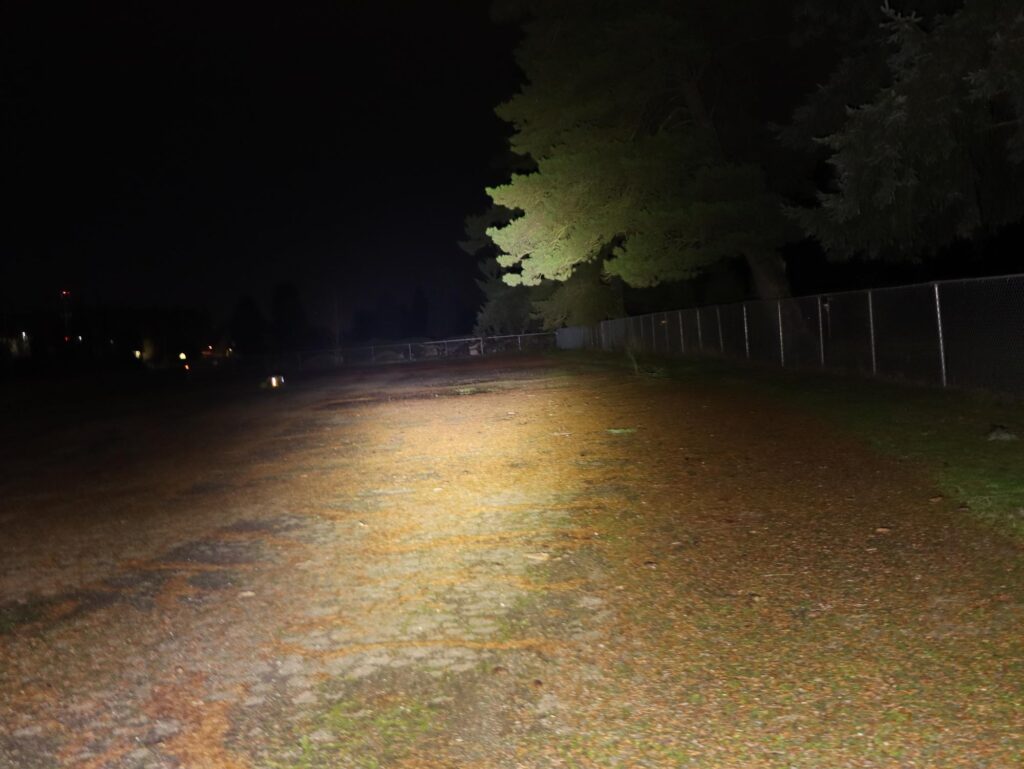

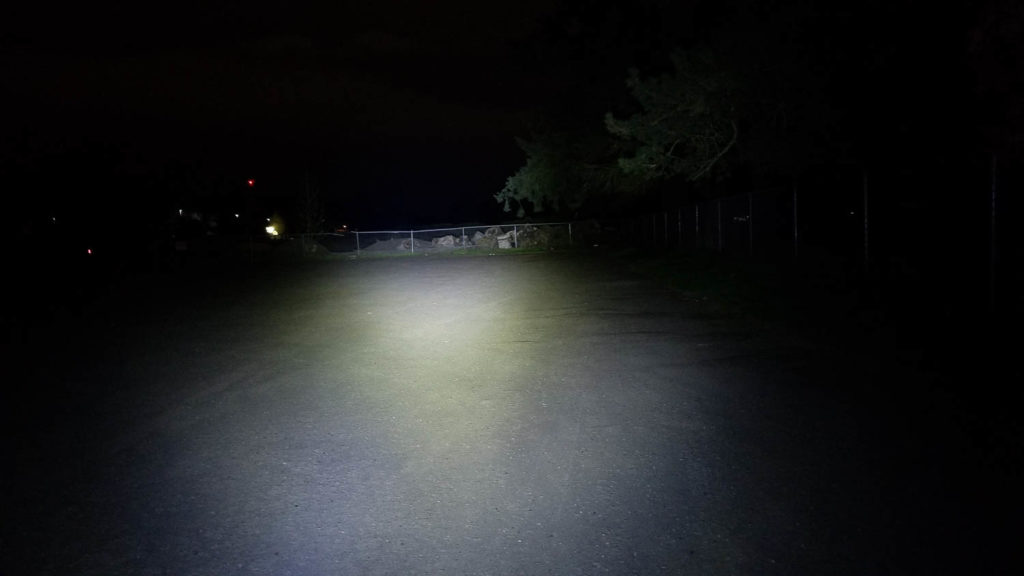
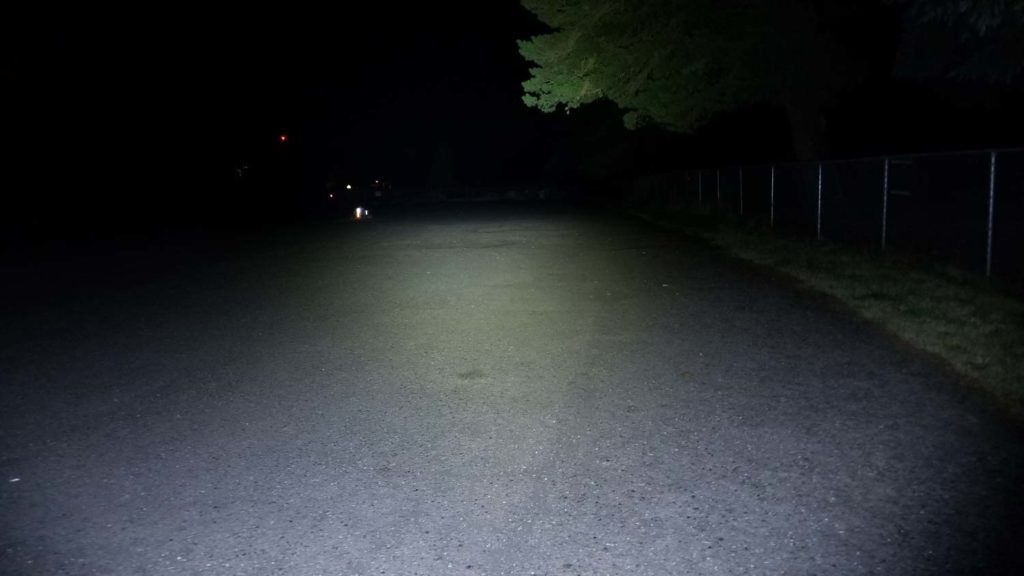
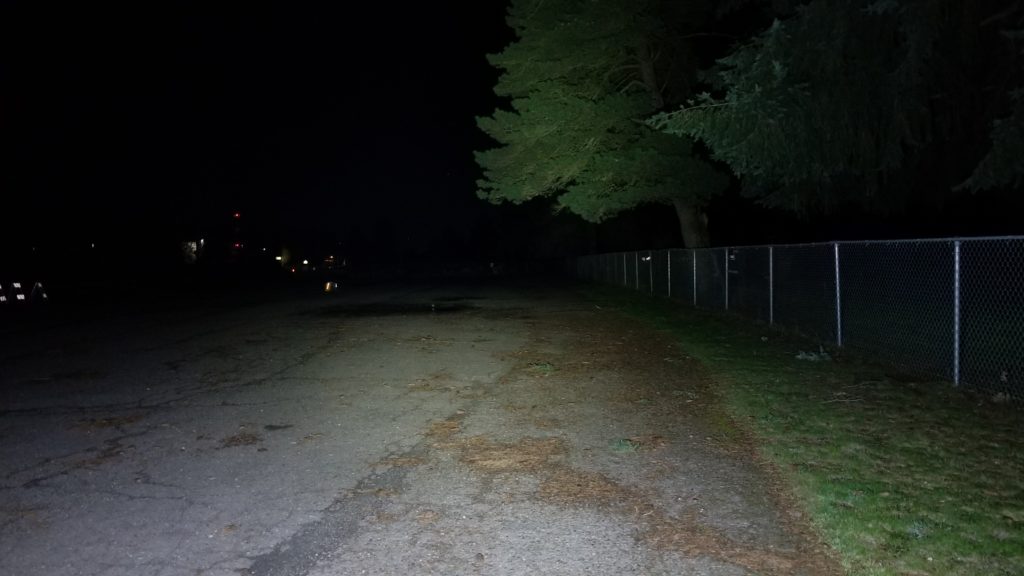
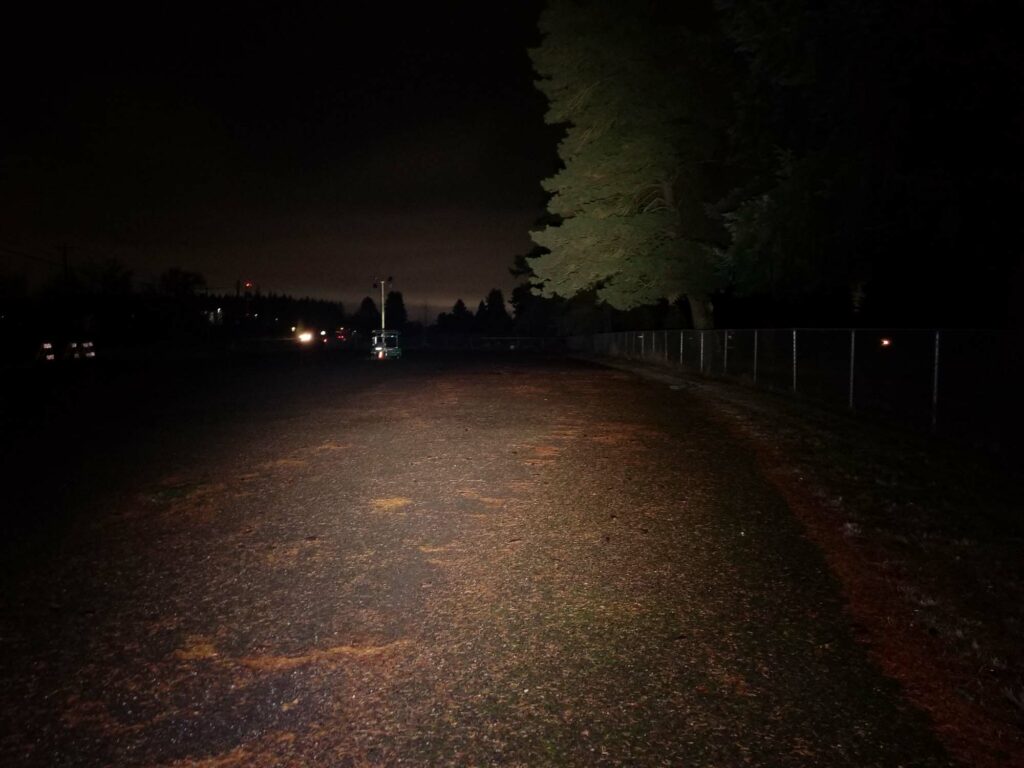
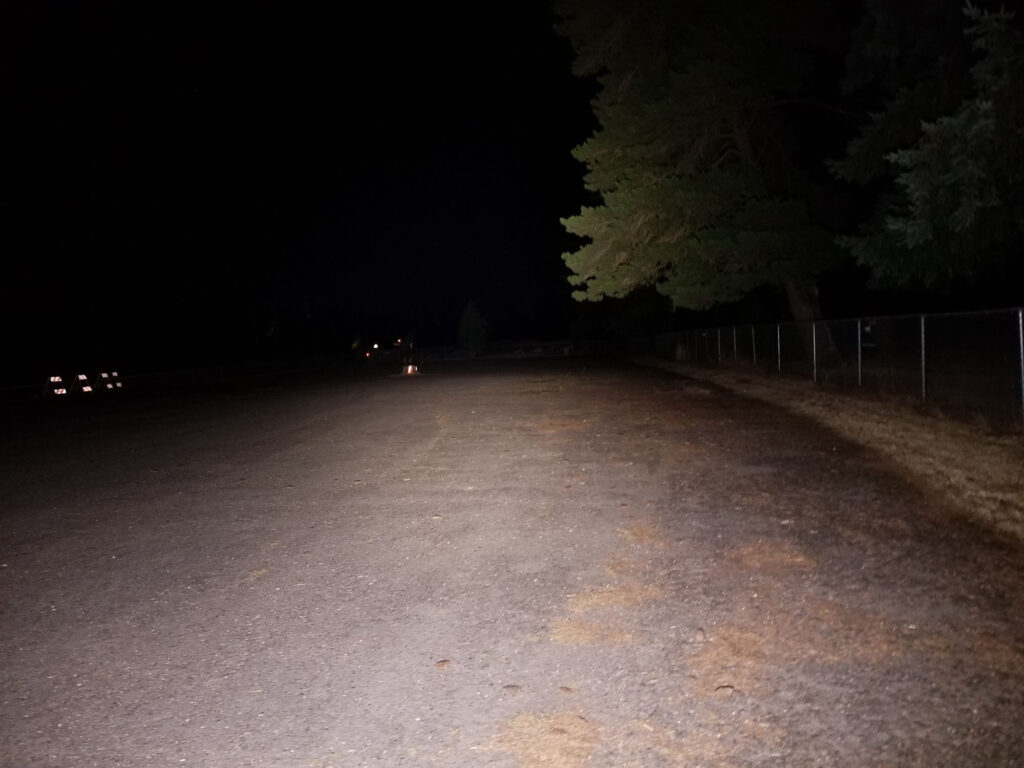
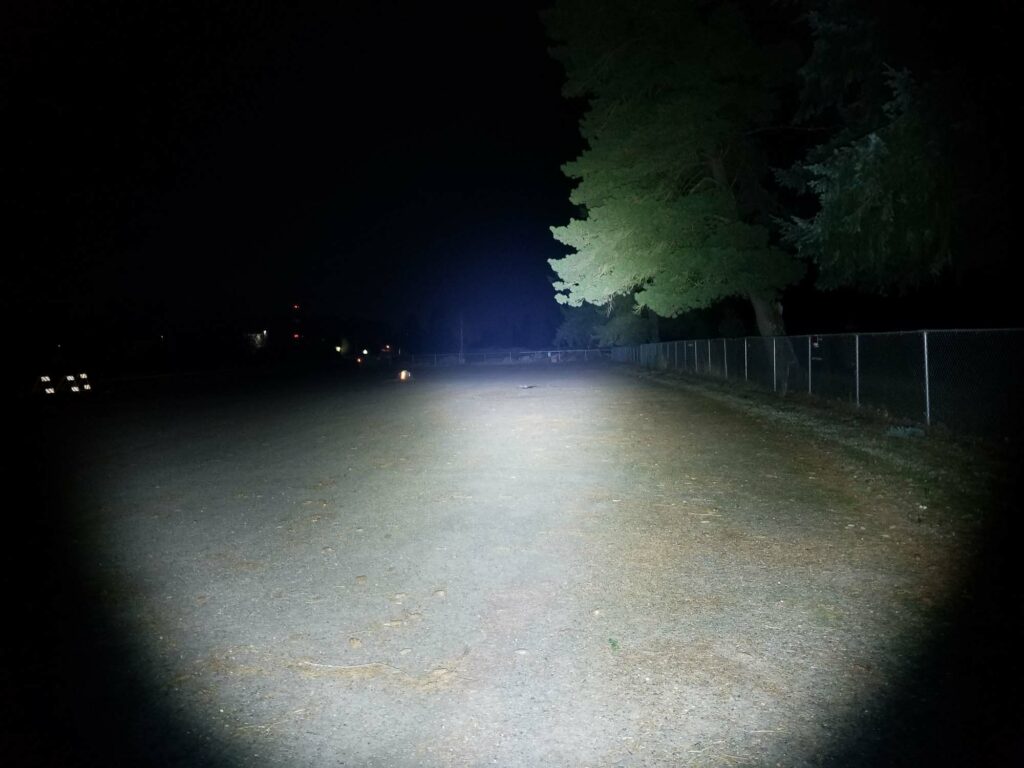
Disclaimer: This flashlight was sent to us for review at no cost by Olight. We have not been paid to review, nor have we been holding back on problems or defects.
Final Verdict
Pros
- Excellent build quality, fit and finish
- Great handling
- High output and great beam distance
- Fully regulated output
- Onboard USB type C charging
- Simple UI
- Lifetime warranty
Cons
- No pocket clip
- No holster included
- No neutral white option
Explanation on star ratings:
1: Avoid: a match would be a better choice – 2: Poor: significant defect or issues; almost unusable – 3: Average: some defects or issues; but still usable 4: Good: recommended (minor issues) – 5: Great: highly recommended

4.5 stars: ★★★★⋆
While our star rating provides a reliable indicator, we encourage you to read the full review to make an informed decision based on your own needs and preferences.
There’s a few things I can count on in life: Death, taxes, and Olight’s commitment to quality, performance, and sales…lots of sales. That aside, what Olight has done here is diversified in the right direction: Giving the masses what they want, which is options. Don’t want a quad with a TIR? No problem. How about neutral tint? Sure! Onboard USB C charging? Coming right up!
Seriously, no other company does things like Olight in that respect, so a round of applause for them. Now, the Seeker 4: I like it! The lone issue I had (my fault) notwithstanding, this is a solid flashlight and will handle just about any general illumination tasks just fine. There’s not a lot wrong with the Seeker 4. It handles nice, has a versatile beam, great build quality, solid performance, and USB C onboard charging. The UI works and is simple enough that novices can pick it up without instruction and use it. I found myself nit picking here, but I didn’t like the lack of a holster or clip provision, and while not a deal-breaker, I’d like to see a neutral white LED option.
Lastly, the perpetual request continues on…I wish Olight would give us the option to BYOB (bring your own battery). Maybe someday perhaps. For now, this is about as good as it gets in this segment. You can’t go wrong with the Acebeam E75, Armytek Prime C2 Pro Max, Thrunite TC20 (V2 or Pro), and Acebeam P17, but I give the Seeker 4 a solid recommendation and 4.5 stars because of the lack of a pocket clip and/or holster.
Buy your Olight Seeker 4 with a discount
Use our exclusive 1lumen discount code to get an extra 10% off anything you order at Olightstore.com (USA). Coupon code: 1lumen
1lumen selects and reviews products personally. We may earn affiliate commissions through our links, which help support our testing.